The European Wold Newton Universe
Timeline
(1911-1920)
1911. The wicked mad scientist Dr.
Coriolis transforms a missing link into a half-human, half-animal beast:
Balaoo. Balaoo spreads terror throughout Paris and kidnaps a beautiful
woman who he tries to take as his mate. Balaoo is finally lured into a trap
and killed. (Gaston Leroux's Balaoo, 1913).
Throughout the year Algy Brett and Alsop Osterman duel
in the skies over Europe. The German Osterman is an inventor with a
grudge against the British. He creates the Gray Ghost, a wonder
aircraft over a hundred feet long with flapping wings and propellers
and armed with a ram capable of sinking an ocean liner. Osterman
begins a reign of terror from the sky, sinking ships and dropping
bombs on them. Algy Brett, a daring young clerk in the British War
Office, finds out about Osterman, and pursues him across the Continent,
until Osterman, on the verge of building a fleet of airships for Germany
to use against the U.K., is killed. (Muriel Pollexfen's Algy Brett stories,
beginning in 1911).
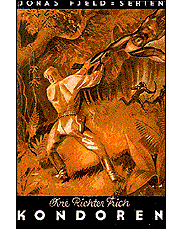 Jonas Fjeld begins a decades-long series of adventures.
Dr. Jonas Fjeld is an enormous, muscular blond Norwegian who lives
in a sprawling castle on the Uranienborg. He is a brilliant scientist
and inventor who is dedicated to warring on the "intenational underworld."
He is assisted in this by his friend and collaborator Ilmari Erko,
a Finnish dwarf and genius inventor who provides Fjeld with his advanced
instruments and weapons and vehicles, such as the Flyvefisken,
a plane/submarine with high-tech weaponry which is capable of sinking
most of the Russian fleet by itself. (Øvre Richter Frich's Jonas
Fjeld novels, beginning with De knyttede naever, 1911).
Jonas Fjeld begins a decades-long series of adventures.
Dr. Jonas Fjeld is an enormous, muscular blond Norwegian who lives
in a sprawling castle on the Uranienborg. He is a brilliant scientist
and inventor who is dedicated to warring on the "intenational underworld."
He is assisted in this by his friend and collaborator Ilmari Erko,
a Finnish dwarf and genius inventor who provides Fjeld with his advanced
instruments and weapons and vehicles, such as the Flyvefisken,
a plane/submarine with high-tech weaponry which is capable of sinking
most of the Russian fleet by itself. (Øvre Richter Frich's Jonas
Fjeld novels, beginning with De knyttede naever, 1911).
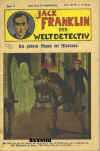 The German adventurer and detective Jack Franklin
has a series of adventures throughout the year. For a brief time
he is known as the "World Detective," largely due to the global scale
of his adventures, which bring him from Bombay to East St. Louis to
Warsaw. (Jack Franklin, der Meisterdetektiv #1-41, 1911). Later
researchers have noted Franklin's strong resemblance to Nick Carter,
but no relationship between them has been established. Similarly, a number
of Franklin's adventurers are startlingly similar to Carter's, but researchers
have been unable to show that this was anything other than coincidence.
The German adventurer and detective Jack Franklin
has a series of adventures throughout the year. For a brief time
he is known as the "World Detective," largely due to the global scale
of his adventures, which bring him from Bombay to East St. Louis to
Warsaw. (Jack Franklin, der Meisterdetektiv #1-41, 1911). Later
researchers have noted Franklin's strong resemblance to Nick Carter,
but no relationship between them has been established. Similarly, a number
of Franklin's adventurers are startlingly similar to Carter's, but researchers
have been unable to show that this was anything other than coincidence.
A “Great
Detective Syndrome” sufferer known as Lord Jackson
begins work as a consulting detective in Madrid. Later in the year
he jousts with Sherlock Holmes. (Aventuras de Lord Jackson,
1911).
Doctor Riccardo de Medici, a “Great Detective Syndrome"
sufferer, begins work as a consulting detective in Rome. He is billed
as "the Italian Sherlock Holmes," a title formerly held by
the late John Siloch. (Umberto Cei's Doctor Riccardo de Medici
stories, beginning in 1911).
The Japanese spy Oka-Yuma is active in Russia. After
much struggle he is defeated by heroic Russians. (Oka-Yuma (newspaper
serial)).
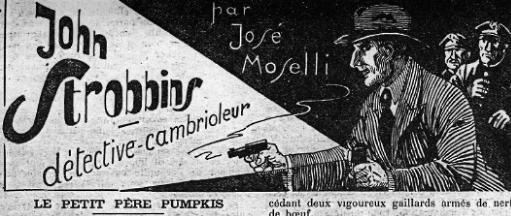 John Strobbins begins a decades-long career of theft.
Strobbins, "young, elegant, and likable," is a very patriotic American,
working out of San Francisco. He is a "virtuoso of burglary" and a master
of disguise. While he does not kill, he can be ruthless; when dealing
with spies he will, for example, inject them with leprosy and then abandon
them on a deserted island. Most of the time, however, Strobbins is a playful
and chivalrous sort, willing to tip off the police as to where he will
strike next, and on occasion helping the police to capture truly evil men.
Strobbins' police nemeses are James Molescott, the Chief of the S.F.P.D.,
and Peter Crainsby, Molescott's assistant. Strobbins is helped by his
butler/assistant Reno. (Jose Moselli's John Strobbins stories, beginning
in 1911). Many of Strobbins' methods and actions were influenced by Arsène
Lupin; it is not known what Lupin thought of Strobbins.
John Strobbins begins a decades-long career of theft.
Strobbins, "young, elegant, and likable," is a very patriotic American,
working out of San Francisco. He is a "virtuoso of burglary" and a master
of disguise. While he does not kill, he can be ruthless; when dealing
with spies he will, for example, inject them with leprosy and then abandon
them on a deserted island. Most of the time, however, Strobbins is a playful
and chivalrous sort, willing to tip off the police as to where he will
strike next, and on occasion helping the police to capture truly evil men.
Strobbins' police nemeses are James Molescott, the Chief of the S.F.P.D.,
and Peter Crainsby, Molescott's assistant. Strobbins is helped by his
butler/assistant Reno. (Jose Moselli's John Strobbins stories, beginning
in 1911). Many of Strobbins' methods and actions were influenced by Arsène
Lupin; it is not known what Lupin thought of Strobbins.
The infamous "ghost bandit" Ténèbras
begins a series of thefts in Paris. (Arnould Galopin's Ténèbras
le bandit fantôme, 1911).
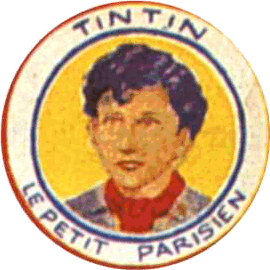 A heroic young Parisian, Tintin, begins a fabulous
series of adventures around the world, both in the skies and underground,
and then later across the solar system. In the atomic-hydrogen-gas-powered
spaceship Bolide Tintin and his friends Professor Saint-Marc,
Yvonne Blanchard, Timmy-Ropp, and Jean du Requirel travel to Mars,
where they encounter the Slavoks, a robotic race of slaves that the
Martians constructed to serve them. The Martians themselves have slender
bodies with enormous heads, and get around with the help of metal boots
and artificial wings. (Marcel Priollet's Les Voyages Aeriens d'un
Petit Parisien a Travers le Monde #1-111, 1911-1913)
A heroic young Parisian, Tintin, begins a fabulous
series of adventures around the world, both in the skies and underground,
and then later across the solar system. In the atomic-hydrogen-gas-powered
spaceship Bolide Tintin and his friends Professor Saint-Marc,
Yvonne Blanchard, Timmy-Ropp, and Jean du Requirel travel to Mars,
where they encounter the Slavoks, a robotic race of slaves that the
Martians constructed to serve them. The Martians themselves have slender
bodies with enormous heads, and get around with the help of metal boots
and artificial wings. (Marcel Priollet's Les Voyages Aeriens d'un
Petit Parisien a Travers le Monde #1-111, 1911-1913)
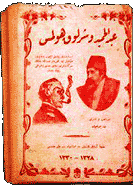 1912. The Turkish detective Avni begins
work in Istanbul. His methods are heavily influenced by both Sherlock
Holmes and Monsieur Lecoq, but in personality he is not
like either of them. To the criminals of Istanbul he quickly becomes
known as "Amanvermez Avni," or "Merciless Avni." (Ebüssüreyya
Sami's Avni novels, beginning in 1912).
1912. The Turkish detective Avni begins
work in Istanbul. His methods are heavily influenced by both Sherlock
Holmes and Monsieur Lecoq, but in personality he is not
like either of them. To the criminals of Istanbul he quickly becomes
known as "Amanvermez Avni," or "Merciless Avni." (Ebüssüreyya
Sami's Avni novels, beginning in 1912).
The French private detective Chantecoq begins
a decades-long series of exploits for France. He is a private detective,
but early on he works as a counter-espionage agent for French intelligence.
He is active for years against the Germans, using technologically-advanced
gadgets provided to him by his inventor friend John Asbury. After
the war he becomes the "King of Detectives," and even clashes with Belphegor.
(Arthur Bernède's Chantecoq stories, beginning with The
Heart of France, 1912).
At the request of Sherlock Holmes the Australian detective
Allan Dickson travels to London and helps Holmes capture "Jack
the Ripper," who turns out to be a sailor on the ship Arabella.
(Arnould Galopin's L’Homme au complet gris, 1912). It is well
known that "Jack the Ripper" was apprehended by Sherlock Holmes
in 1888. (Ellery Queen's A Study in Terror, 1966). The being who
Holmes recaptured in 1912 was the "Redjac" entity; Holmes no doubt
had his reasons for not disclosing to Dickson the true story behind "Jack
the Ripper" and for not telling Dickson that "Jack the Ripper" had been
caught 24 years before. (see also Ethel King below and 1921 & 1928).
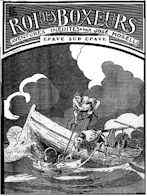 The French boxer Marcel Dunot begins a remarkable
series of adventures which lasts for almost thirty years. Dunot
is the "King of Boxers," an adventurous pugilist whose travels bring
him into contact with all sorts of criminal types. When Dunot goes
to America he tangles with the boxer Fred MacFarlan, the boss of the
criminal organisation the Black Hand. In Honduras Dunot is named the
Minister of the Navy in order to stop the civil war raging there. Dunot
fights the Black Hand in China and Russia. Dunot fights with Frank Flint,
an auto magnate, and Mathias Landers, the rubber king. In Haiti Dunot defeats
the plans of Charlemagne Sale-Trou, who planned to take over the island
and become its Emperor. During WW1 Dunot fought the Germans with extreme
savagery, traveling to Belgium, the Balkans, German East Africa and Central
America, especially the Panama Canal, and finding and killing the brutish
Germans wherever he found them. After the war it was more of the same,
Dunot tangling with Mme. Eventail, a sinister Asian bandit queen, and
later culminating with Dunot's battle against Japanese spies and the
implacable spymaster Nagoaka in Shanghai. In the late 1930s Dunot retired
to his South American mansion, living off the proceeds of the gold strike
he found in the Klondyke. (Jose Moselli’s Marcel Dunot stories, beginning
in 1912).
The French boxer Marcel Dunot begins a remarkable
series of adventures which lasts for almost thirty years. Dunot
is the "King of Boxers," an adventurous pugilist whose travels bring
him into contact with all sorts of criminal types. When Dunot goes
to America he tangles with the boxer Fred MacFarlan, the boss of the
criminal organisation the Black Hand. In Honduras Dunot is named the
Minister of the Navy in order to stop the civil war raging there. Dunot
fights the Black Hand in China and Russia. Dunot fights with Frank Flint,
an auto magnate, and Mathias Landers, the rubber king. In Haiti Dunot defeats
the plans of Charlemagne Sale-Trou, who planned to take over the island
and become its Emperor. During WW1 Dunot fought the Germans with extreme
savagery, traveling to Belgium, the Balkans, German East Africa and Central
America, especially the Panama Canal, and finding and killing the brutish
Germans wherever he found them. After the war it was more of the same,
Dunot tangling with Mme. Eventail, a sinister Asian bandit queen, and
later culminating with Dunot's battle against Japanese spies and the
implacable spymaster Nagoaka in Shanghai. In the late 1930s Dunot retired
to his South American mansion, living off the proceeds of the gold strike
he found in the Klondyke. (Jose Moselli’s Marcel Dunot stories, beginning
in 1912).
To date no researchers have explored Dunot’s boxing record
in sufficient detail, and it is not possible to say with any certainty
whether he fought any of the great boxers of his day. (See Note #6).
Sherlock Holmes and Doctor Watson return
to the moors of England to investigate the mystery of the “Cat of
the Baskervilles.” (Chr. Stub-Jørgensen’s Under Mørkets
Vinger, 1919).
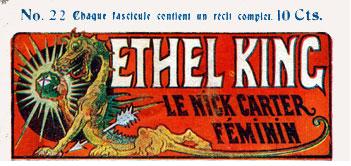 Ethel King, a Philadelphian, begins a successful
career as a female private detective. Her French biographer, Jean
Petithuguenin, is first told about her by Nick Carter himself.
(Ethel King, ein weiblicher Sherlock Holmes #1-201,
1912-1915, and Jean Petithuguenin's Ethel King, le Nick Carter
feminin #1-101, 1912-1914). Later in the year she apprehends "Jack
the Ripper." (Jean Petithuguenin's "Jack l'Éventreur, le tueur
de femmes," Ethel King #3, 1912). The "Jack the Ripper" King caught
is by all accounts different from the one caught by Allan Dickson
and Sherlock Holmes earlier in the year (see above) and different
from the one caught by Frank Allan and Sexton Blake in the
1920s, and is clearly
the "Redjac" entity rather than the original "Jack the Ripper" who
was apprehended by Holmes in 1888. (Ellery Queen's A Study in Terror).
Ethel King, a Philadelphian, begins a successful
career as a female private detective. Her French biographer, Jean
Petithuguenin, is first told about her by Nick Carter himself.
(Ethel King, ein weiblicher Sherlock Holmes #1-201,
1912-1915, and Jean Petithuguenin's Ethel King, le Nick Carter
feminin #1-101, 1912-1914). Later in the year she apprehends "Jack
the Ripper." (Jean Petithuguenin's "Jack l'Éventreur, le tueur
de femmes," Ethel King #3, 1912). The "Jack the Ripper" King caught
is by all accounts different from the one caught by Allan Dickson
and Sherlock Holmes earlier in the year (see above) and different
from the one caught by Frank Allan and Sexton Blake in the
1920s, and is clearly
the "Redjac" entity rather than the original "Jack the Ripper" who
was apprehended by Holmes in 1888. (Ellery Queen's A Study in Terror).
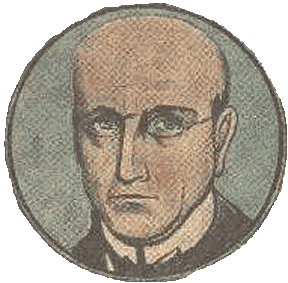 The insane surgeon and master criminal Dr. Cornélius
Kramm makes his debut. Kramm is known as the "Sculptor of Human
Flesh" and is given to altering the features of other people against
their will. Kramm and his brother Fritz rule an international crime
syndicate known as the "Red Hand." Eventually Kramm and the Red Hand
are defeated by an international alliance of heroes led by the brilliant
scientist and adventurer Prosper Bondonnat. (Gustave LeRouge's Dr. Kramm
novels, beginning with Le Mystérieux Docteur Cornélius,
1913). For more information on Kramm, see Dr. Lofficier's dossier.
The insane surgeon and master criminal Dr. Cornélius
Kramm makes his debut. Kramm is known as the "Sculptor of Human
Flesh" and is given to altering the features of other people against
their will. Kramm and his brother Fritz rule an international crime
syndicate known as the "Red Hand." Eventually Kramm and the Red Hand
are defeated by an international alliance of heroes led by the brilliant
scientist and adventurer Prosper Bondonnat. (Gustave LeRouge's Dr. Kramm
novels, beginning with Le Mystérieux Docteur Cornélius,
1913). For more information on Kramm, see Dr. Lofficier's dossier.
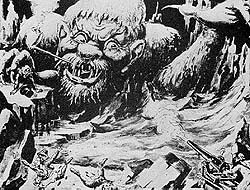 The French inventor and scientist Professor Maboul
creates the “aerobus,” a dirigible capable of traveling long distances
very quickly. He assembles a team of six professors from England,
the U.S., Germany, Spain, China and Japan, and they set forth to explore
the North Pole. Unfortunately, they encounter the “géant des
neiges” (giant of the snows), an enormous giant who tries to eat
the explorers. Maboul and the other professors escape and return in triumph
to Paris. (Georges Méliès’ La Conquête du pôle,
1912). It is obviously a part of the historical record that giants previously
existed on Earth. (Moore and O’Neill’s The League of Extraordinary
Gentlemen, v2, 2003). But nearly all of them are thought to have
been killed off centuries ago.
The French inventor and scientist Professor Maboul
creates the “aerobus,” a dirigible capable of traveling long distances
very quickly. He assembles a team of six professors from England,
the U.S., Germany, Spain, China and Japan, and they set forth to explore
the North Pole. Unfortunately, they encounter the “géant des
neiges” (giant of the snows), an enormous giant who tries to eat
the explorers. Maboul and the other professors escape and return in triumph
to Paris. (Georges Méliès’ La Conquête du pôle,
1912). It is obviously a part of the historical record that giants previously
existed on Earth. (Moore and O’Neill’s The League of Extraordinary
Gentlemen, v2, 2003). But nearly all of them are thought to have
been killed off centuries ago.
A nameless boy informally known as “the Parisian apprentice”
has several months’ worth of adventures in locales around the world
in his "hydroaeroplane." (Arnould Galopin's Aventures d'un
Apprenti Parisien #1-100, 1912-1914).
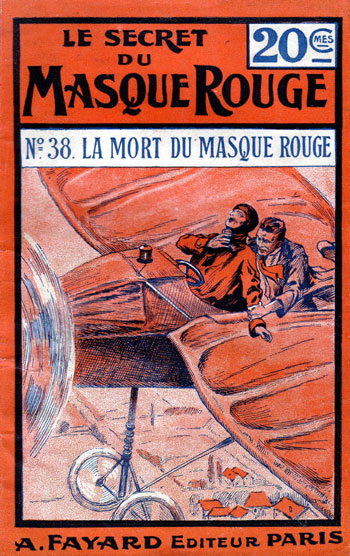 "Masque Rouge," or "Red Mask," a French master
criminal, begins his duel with the detective Mr. Barthélémy,
a.ka. "Oeil-de-Chat" (eye of the cat). Barthélémy
discovers that Red Mask is apparently the son that Barthélémy
abandoned years ago to a Romany (Gypsy) woman. Red Mask kills Henriette,
Barthélémy's daughter and Red Mask's sister, and then
drives Marguerite, Barthélémy's other daughter, insane.
But at the last Barthélémy discovers that both of his
daughter are alive and well, and that Red Mask is not, after all, Barthélémy's
son. Red Mask dies after Barthélémy throws him from a
plane. (Gaston René's Le Secret du Masque Rouge #1-38,
1912).
"Masque Rouge," or "Red Mask," a French master
criminal, begins his duel with the detective Mr. Barthélémy,
a.ka. "Oeil-de-Chat" (eye of the cat). Barthélémy
discovers that Red Mask is apparently the son that Barthélémy
abandoned years ago to a Romany (Gypsy) woman. Red Mask kills Henriette,
Barthélémy's daughter and Red Mask's sister, and then
drives Marguerite, Barthélémy's other daughter, insane.
But at the last Barthélémy discovers that both of his
daughter are alive and well, and that Red Mask is not, after all, Barthélémy's
son. Red Mask dies after Barthélémy throws him from a
plane. (Gaston René's Le Secret du Masque Rouge #1-38,
1912).
A nameless German sailor is shipwrecked in the South
Pacific and spends the year wandering from deserted island to scarcely
inhabited island, encountering “medusas,” horrific storms, pirates,
and the like. Stories are told across the South Pacific about the
“New Robinson” and his bravery in the face of cruel fate. He
is finally rescued in 1913. (Heinz Waldau’s Ein Neuer Robinson
#1-60, 1912-1913).
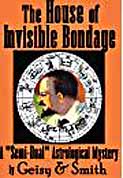 Prince Abduel Omar of Persia, the astrologist popularly
known as “Semi-Dual,” comes to the public’s notice, and begins
a career which lasts for decades. Semi-Dual becomes one of the greatest
occult detectives of the years before WW2, using his telepathy, insight
into humans, and infallible astrological predications to protect a
number of innocent men and women (usually women) from a variety of
evil men. Semi-Dual works from his office on the 20th floor of the Urania
Building in New York City. Semi-Dual’s enemies range from the very
humble–gangsters and treacherous French Foreign Legion officers–to
the mightily wicked–the Black Brotherhood, a cult of devil-worshipers
devoted to the cause of “Erlik, Commander of the Hosts of All Evil.”
(Giesy & Smith’s Semi-Dual stories, beginning in 1912).
Prince Abduel Omar of Persia, the astrologist popularly
known as “Semi-Dual,” comes to the public’s notice, and begins
a career which lasts for decades. Semi-Dual becomes one of the greatest
occult detectives of the years before WW2, using his telepathy, insight
into humans, and infallible astrological predications to protect a
number of innocent men and women (usually women) from a variety of
evil men. Semi-Dual works from his office on the 20th floor of the Urania
Building in New York City. Semi-Dual’s enemies range from the very
humble–gangsters and treacherous French Foreign Legion officers–to
the mightily wicked–the Black Brotherhood, a cult of devil-worshipers
devoted to the cause of “Erlik, Commander of the Hosts of All Evil.”
(Giesy & Smith’s Semi-Dual stories, beginning in 1912).
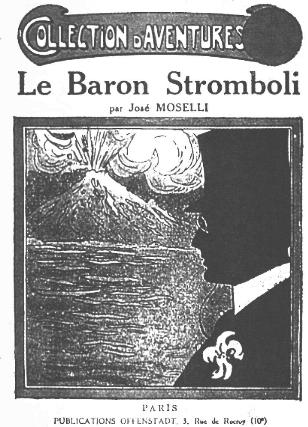 The Italian gentleman thief Baron Cesare Stromboli
begins an audacious, profitable, and highly successful career in crime.
He has a number of similarities, in manner, method, and personality,
to Arsène Lupin, but is enough of an individual to rise
above the “Great Detective
Syndrome" which affected so many of the detectives influenced
by Sherlock Holmes. Stromboli is an "international gentleman,"
active around the world. He is tall, thin, and elegant, a raconteur
and scholar, who is as graceful in defeat as he is in victory. He is not
nobility by birth, but was given the title of Baron after having blackmailed
the Emperor. (Jose Moselli’s Baron Stromboli stories, beginning in 1912).
Stromboli’s biographer names the emperor as “Othon II,” but this is clearly
a fictional name. It is more likely that the emperor in question was the
Austrian emperor Francis Joseph I.
The Italian gentleman thief Baron Cesare Stromboli
begins an audacious, profitable, and highly successful career in crime.
He has a number of similarities, in manner, method, and personality,
to Arsène Lupin, but is enough of an individual to rise
above the “Great Detective
Syndrome" which affected so many of the detectives influenced
by Sherlock Holmes. Stromboli is an "international gentleman,"
active around the world. He is tall, thin, and elegant, a raconteur
and scholar, who is as graceful in defeat as he is in victory. He is not
nobility by birth, but was given the title of Baron after having blackmailed
the Emperor. (Jose Moselli’s Baron Stromboli stories, beginning in 1912).
Stromboli’s biographer names the emperor as “Othon II,” but this is clearly
a fictional name. It is more likely that the emperor in question was the
Austrian emperor Francis Joseph I.
It is not known whether Baron Stromboli and Arsène
Lupin ever met, nor what Lupin’s thoughts were on his seeming imitator.
Stromboli was hardly the first gentleman thief to imitate Lupin (or,
phrased more diplomatically, to have been heavily influenced by him)
and was not the last, but he was the most successful, and it is curious,
at the remove of decades, that Lupin's comments on his imitators, particularly
the successful ones like Stromboli or Filip Collin (see 1914
below), have not been recorded. It may be that future researchers will
unearth an encounter between them or at least Lupin's thoughts on the
matter.
Zigomar clashes with Nick Carter. (Zigomar
contre Nick Carter, 1912).
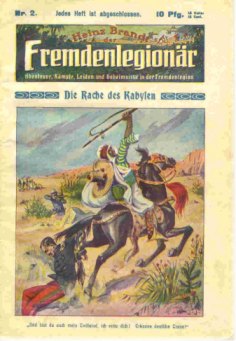 1913. Two Germans, Heinz Brandt
and his brother Fritz, enlist in the French Foreign Legion, beginning
a remarkable career. Throughout this year and the first half of the
next, the brothers serve in the Foreign Legion, helping innocent people
and supporting France against the efforts of various native peoples
in Asia and Africa. The Brandts serve proudly, despite the sadism of
the French commanders. When World War One breaks out, the Brandts desert
from the Legion and travel to Belgium tojoin the German troops. The brothers
are eventually promoted to Corporal and win the Iron Cross. They fight
the British and French across most of Europe, in every famous battle
in France, in Russia and in the Balkans. After the war ended the pair
rejoin the Foreign Legion and return to North Africa. In 1931 Heinz’s son,
Rolf Brandt, entered the Legion. (Gustav Frohlich’s Heinz Brandt
der Fremdenlegionär #1-332, 1913-1921, and Fremdenlegionär
Brandt, beginning in 1956).
1913. Two Germans, Heinz Brandt
and his brother Fritz, enlist in the French Foreign Legion, beginning
a remarkable career. Throughout this year and the first half of the
next, the brothers serve in the Foreign Legion, helping innocent people
and supporting France against the efforts of various native peoples
in Asia and Africa. The Brandts serve proudly, despite the sadism of
the French commanders. When World War One breaks out, the Brandts desert
from the Legion and travel to Belgium tojoin the German troops. The brothers
are eventually promoted to Corporal and win the Iron Cross. They fight
the British and French across most of Europe, in every famous battle
in France, in Russia and in the Balkans. After the war ended the pair
rejoin the Foreign Legion and return to North Africa. In 1931 Heinz’s son,
Rolf Brandt, entered the Legion. (Gustav Frohlich’s Heinz Brandt
der Fremdenlegionär #1-332, 1913-1921, and Fremdenlegionär
Brandt, beginning in 1956).
The Swedish “Great Detective Syndrome"
sufferer Leo Carring begins work in Stockholm as a consulting
detective. Despite his obvious debt to Sherlock Holmes, Carring
shows no gratitude toward his role model, instead criticizing Holmes
for “sloppy handling” of evidence and for “undeserved luck.” Carring is
not just a consulting detective but also a highly successful lawyer. He
has a forceful personality and is enthusiastic about physical combat, especially
against those who he disapproves of (Communists and Jews). (Duse and
Regis’ Leo Carring novels, beginning with Stilettkäppen,
1913).
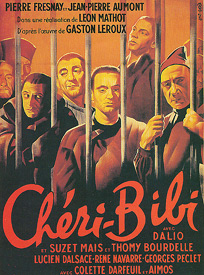 Chéri-Bibi, a mysterious magician and escape artist, is
charged with murdering his father. Chéri-Bibi is innocent and is
being framed by a romantic rival, Max, who combines with Chéri-Bibi's
two-timing girlfriend Vera to set Chéri-Bibi up. Chéri-Bibi
is forced to become an outlaw, and for a while becomes the king of thieves,
the thief that other thieves and the police fear, the one with the magic
touch for escape and the ability to rally other thieves to him. However,
he eventually proves himself innocent and then begins fighting crime, using
his various skills to catch the bad guys. (Gaston Leroux's Chéri-Bibi,
1930). (Those interested in further information on Chéri-Bibi are advised
to consult Dr. Lofficier's
dossier on him).
Chéri-Bibi, a mysterious magician and escape artist, is
charged with murdering his father. Chéri-Bibi is innocent and is
being framed by a romantic rival, Max, who combines with Chéri-Bibi's
two-timing girlfriend Vera to set Chéri-Bibi up. Chéri-Bibi
is forced to become an outlaw, and for a while becomes the king of thieves,
the thief that other thieves and the police fear, the one with the magic
touch for escape and the ability to rally other thieves to him. However,
he eventually proves himself innocent and then begins fighting crime, using
his various skills to catch the bad guys. (Gaston Leroux's Chéri-Bibi,
1930). (Those interested in further information on Chéri-Bibi are advised
to consult Dr. Lofficier's
dossier on him).
The great French aviator Fifi begins a series
of adventures around the world, particularly in the French colonies
in southeast Asia. (Arnould Galopin’s Les Nouvelles Aventures de
Fifi, 1913-1914). Fifi’s actions during WW1 are not known, but
he was surely active on the French side.
Harry Houdini has his stage routine sabotaged by a
group of "Handcuff Kings." Houdini is rescued by Sherlock Holmes.
(Auf den Spuren Houdinis, 1916).
Horst Kraft, a German pre-teenager, moves to South
America with his family and has a series of adventures across the
continent, often with a set of pre-teen friends. When World War One
begins Kraft leaves his family and moves to Tsingtao, in China, and fights
the French and British there. When the war ends Kraft has a series of
adventures in Macao, China, Japan, Alaska, Bangkok, North Africa, and Delhi.
(Horst Kraft der Pfadfinder #1-313, 1913-1916 and 1919-1920).
Lord Lister attempts to fleece a dissolute American
playboy of his millions, with the ultimate goal of using the man’s
money to build housing for the poor of New York City. Lister is pursued
both by Inspector Baxter of Scotland Yard and by Nick Carter.
(Muhammad bin Muhammad Said's Cheritera Kechurian Lima Million Ringgit,
1922).
The French mad scientist Miramar sets in motion
a scheme to take over the world. This involves, among other things,
performing strange organ transplants and grafts on various men and
women. (Guillaume Livet’s Miramar, L'Homme aux Yeux de Chat,
1913).
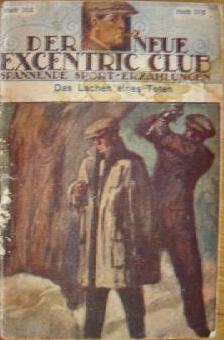 The New Eccentric Club, allies of Percy Stuart
(see below), come to the attention of the public and press for their
global adventures. They are a group of English gentlemen who solve
murders and similar vile crimes, both in London and around the world,
from Niagara Falls to Beijing to Paris and all points between, on the
land, under the sea’s surface, and in the air. They often worked with
Percy Stuart, but on occasion went off on their own. Sometimes they
engaged in races, to see who could cross the oceans the fastest, but
more often their stories involved murders and other vilenesses. They
are extremely selective in who they accept into their ranks, and their standards
are often eccentric (as befits their name). Usually would-be members must
pass a strenuous series of tests, and even applicants with otherwise sterling
records of crimefight, like Percy Stuart, are forced to prove themselves
before being admitted to the Club. (Der Neue Excentric Club #1-534,
1920-1927).
The New Eccentric Club, allies of Percy Stuart
(see below), come to the attention of the public and press for their
global adventures. They are a group of English gentlemen who solve
murders and similar vile crimes, both in London and around the world,
from Niagara Falls to Beijing to Paris and all points between, on the
land, under the sea’s surface, and in the air. They often worked with
Percy Stuart, but on occasion went off on their own. Sometimes they
engaged in races, to see who could cross the oceans the fastest, but
more often their stories involved murders and other vilenesses. They
are extremely selective in who they accept into their ranks, and their standards
are often eccentric (as befits their name). Usually would-be members must
pass a strenuous series of tests, and even applicants with otherwise sterling
records of crimefight, like Percy Stuart, are forced to prove themselves
before being admitted to the Club. (Der Neue Excentric Club #1-534,
1920-1927).
The French detective Tony Pacot begins a two-year-long
fight against Jim Schader and his “X” gang. Pacot’s nickname is “Mirobal”
(The Prodigious). (Léon Sazie’s Tony Pacot stories, 1913-1914).
The Spanish “Great Detective Syndrome”
sufferer known only as “Ros-Koff” opens a consulting
detective agency in Madrid. (Aventuras del detective Ros-Koff,
1913).
The Belgian “Great Detective Syndrome”
sufferer known only as "Smantor" opens a consulting detective
agency in Brussels. (Smantor, le celebre détective belge
#1-4, 1915).
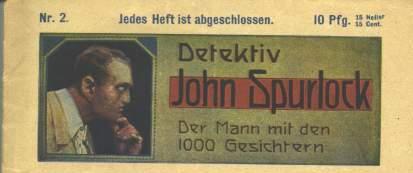 The “Great Detective Syndrome”
sufferer John Spurlock has a very successful year. A German-American
consulting detective, Spurlock is based in New York City but is active
around the world. He is known as “the man of a thousand disguises” but
generally takes over Sherlock Holmes in both manner and method. His
stories and enemies occasionally verge on the fantastic, as in the case
his biographer labels “the Message from Mars,” when Spurlock is almost
single-handedly responsible for defeating an incursion of the same
Martians who invaded the Earth in 1898. (Detektiv John Spurlock
#1-36, 1915). There would be other, later attempts by the Martians
to invade Earth, and they would be defeated as this one was. But, ominously,
this attack proved that the Martians were capable of adapting to Earth's
bacteria, and would require more vigorous weapons to defeat them.
The “Great Detective Syndrome”
sufferer John Spurlock has a very successful year. A German-American
consulting detective, Spurlock is based in New York City but is active
around the world. He is known as “the man of a thousand disguises” but
generally takes over Sherlock Holmes in both manner and method. His
stories and enemies occasionally verge on the fantastic, as in the case
his biographer labels “the Message from Mars,” when Spurlock is almost
single-handedly responsible for defeating an incursion of the same
Martians who invaded the Earth in 1898. (Detektiv John Spurlock
#1-36, 1915). There would be other, later attempts by the Martians
to invade Earth, and they would be defeated as this one was. But, ominously,
this attack proved that the Martians were capable of adapting to Earth's
bacteria, and would require more vigorous weapons to defeat them.
 Percy Stuart, a rich, young English lord, begins
a noteworthy career of adventuring. He begins as an independent crimefight,
but when he hears about the New Eccentric Club in London he
tries to join them. But he is told that he has to solve 197 mysteries--the
solving of unpunished crimes, the discovery of missing persons, and the
like--to qualify for membership. For years Stuart solves cases, but
he is only partially able to solve the 197th case, and so, shamed, he
vows to solve another 197. His cases take him around the world, even bringing
him into the plains of America, where he drives an armored landrover
(quite similar to the inventions of Frank Reade, Jr.) and fights
off the attacks of a group of marauding natives.
Percy Stuart, a rich, young English lord, begins
a noteworthy career of adventuring. He begins as an independent crimefight,
but when he hears about the New Eccentric Club in London he
tries to join them. But he is told that he has to solve 197 mysteries--the
solving of unpunished crimes, the discovery of missing persons, and the
like--to qualify for membership. For years Stuart solves cases, but
he is only partially able to solve the 197th case, and so, shamed, he
vows to solve another 197. His cases take him around the world, even bringing
him into the plains of America, where he drives an armored landrover
(quite similar to the inventions of Frank Reade, Jr.) and fights
off the attacks of a group of marauding natives.
After solving his 394th case, he finally joins the New
Eccentric Club. He continues solving cases and is told that if he
solves another 197 cases he will be offered the presidency of the
Club. 140 cases later he saves the life of the Club president’s daughter
and becomes her husband, positioning himself to become the President’s
successor. (Lord Percy vom Excentric Club #1-44, and Percy
Stuart vom Excentric Club #45-134, from 1913 through 1916).
Percy's son apparently moved to America, for Percy's grandson
(also named Percy) had American citizenship in 1969 when he attempts
to join the new New Eccentric Club. (Percy Stuart (television
show), 1969).
Claus Timm begins years of service in the German
colonies in Africa. He is a Great White Hunter as well as an informal
agent of the German government and serves the cause of Germany, fighting
Allied spies and helping innocent whites in Africa. He is active in the
Cameroon, the Congo, San Thome, and the Nyika Plateau, often assisted
by his wife Ulla. (Willi Richard Sachse’s Claus Timm, der Held von
Kamerun #1-19, 1934-1935).
1914. Filip
Collin, a Swedish professor at Lund University, begins a series
of crimes. A gentleman thief with several of the characteristics of
Arsène Lupin, Collin takes exile well, assuming the alias
of “Professor Pelotard” and commits a number of high profile crimes across
the Continent. He also, on occasion, helps the innocent, applying his
logic and wits to solve crimes as well as commit them. Like Lupin but
unlike most other gentleman thieves, Collin is a genial wit who does not
take his crimes or himself too seriously. (“Frank Heller”/Martin Gunnar
Serner’s Fillip Collin novels, beginning with Herr Collins affärer
i London, 1914). It is not recorded whether or not Lupin ever met
Collin or what Lupin’s thoughts on Collin were.
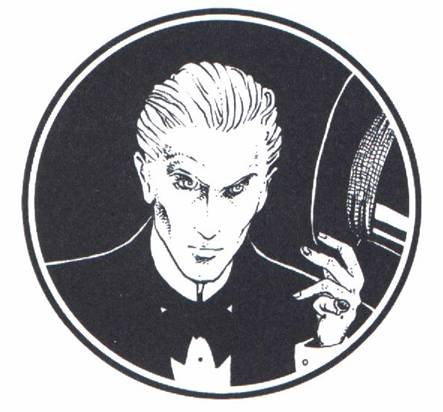 In the last half of the year, after World War One has begun,
the patriotic Frenchman Paul Delroze foils the schemes of the
German spy the Countess Hemine de Hohenzollern. Delroze is assisted by
Arsène Lupin. (Maurice Leblanc's L'Eclat d'Obus,
1915). The royal Hohenzollern family have traditionally been German. However,
in February 1866 Prince Carol I, of the Hohenzollern-Sigmaringens of southern
Germany, was nominated by Romanian leader Ion Bratianu to become Romania's
new prince. Carol (1839-1914) was childless, leaving his elder brother
Leopold next in line to the throne. In 1880 Leopold renounced his right
of succession in favor of his son William, who in 1888 surrendered his
claim in favor of his younger brother, King Ferdinand I (1865-1927). Ferdinand
and his wife, Princess Marie of Edinburgh, had three daughters and three
sons.
In the last half of the year, after World War One has begun,
the patriotic Frenchman Paul Delroze foils the schemes of the
German spy the Countess Hemine de Hohenzollern. Delroze is assisted by
Arsène Lupin. (Maurice Leblanc's L'Eclat d'Obus,
1915). The royal Hohenzollern family have traditionally been German. However,
in February 1866 Prince Carol I, of the Hohenzollern-Sigmaringens of southern
Germany, was nominated by Romanian leader Ion Bratianu to become Romania's
new prince. Carol (1839-1914) was childless, leaving his elder brother
Leopold next in line to the throne. In 1880 Leopold renounced his right
of succession in favor of his son William, who in 1888 surrendered his
claim in favor of his younger brother, King Ferdinand I (1865-1927). Ferdinand
and his wife, Princess Marie of Edinburgh, had three daughters and three
sons.
Little is known about the personal background and history of
the notorious master thief Zenith the Albino; in the words of
his biographer, when describing the "ribbon of a foreign order" which
Zenith habitually wore on the lapel of his jacket, "it is a matter about
which Zenith himself would not have spoken." But during one of his conflicts
with the detective Sexton Blake it was revealed that Zenith was
actually Romanian nobility. When he made his debut against Sexton Blake,
in 1919 (see below), Zenith was only in his mid-20s, which would place
his birth in the mid-1890s. King Ferdinand's first son, Carol II, was born
in 1893; the first daughter, Elizabeth, was born in 1894; the second daughter,
Mignon, was born in 1900. This gap, from a family eager to produce children,
is curious.
The conclusion which the conscientious researcher must reach
is that Zenith's birth to King Ferdinand and Queen Marie was hushed up,
for obvious reasons: an albino Prince would be seen as evidence of a
flaw, not in Ferdinand and Marie but in the Hohenzollerns as a whole.
Zenith must have endured a personal kind of exile, seeing his father
only rarely (for the King would have felt required to dedicate most of
his time to those of his children who could be displayed in public) and
forever bearing some sort of sense that his very existence brought shame
to his family.
So Zenith was related, however, distantly, to the Countess Hermine
who Delroze and Lupin defeated. But Zenith had other, even more elevated,
relations. Zenith's mother, Queen Marie, was the granddaughter of both
Queen Victoria and Tsar Alexander II of Russia.
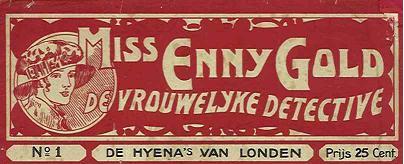 The Dutch female detective Enny Gold begins solving
crimes across Europe as an independent investigator. (Miss Enny
Gold, De Vrouwelyke Detective).
The Dutch female detective Enny Gold begins solving
crimes across Europe as an independent investigator. (Miss Enny
Gold, De Vrouwelyke Detective).
The German wanderer and adventurer Konrad Götz
begins his wandering and adventures. For the first six months of the
year he is active around the Mediterranean, but at the end of June he
is in Sarajevo and witnesses the murder of Archduke Francis Ferdinand.
When Germany declares war on Russia, France, and Belgium at the beginning
of August, Götz is stuck in Serbia, so he joins the German army
in what his biographer describes as the “revenge-war against Serbia."
(Konrad Götz der Wandervogel #1-47, 1914-1915). The sudden
silence of Götz’s biographer after 1915 likely means that Götz
died during WW1.
 The Dutch occult detective Harrison solves a series
of supernatural crimes. (Harrison, de Detective Spiritist).
The Dutch occult detective Harrison solves a series
of supernatural crimes. (Harrison, de Detective Spiritist).
Marc Jordan, a patriotic French detective, gains
fame in France in the months before the war for his crime-solving.
He is seen as being the quintessential Frenchmen for his humor, heartiness,
gaiety, verve and elan, and is more beloved by the common people than
other detectives who have been active for much longer. (Jules de Gastyne’s
Marc Jordan, exploits surprenants du plus grand détective
francais #1-65, 1914). Unfortunately, the sudden silence on the part of
Jordan’s biographer would seem to indicate that Jordan, like many another
patriotic Frenchman, enlisted in the army during WW1 and was killed in combat..
A heroic new crimefighter appears in France: Judex. (Bernède
& Feuillade's Judex, 1917, and The New Mission of Judex,
1918). For more information on Judex, please see Dr. Lofficier's dossier
on him.
A member of the French Foreign Legion, whose name has
not been recorded in English-language history books, begins a series
of exotic adventures. The Legionnaire is active with a detachment
of the Legion in action in both Africa and Asia. He fights pirates
in the Sahara, hunts down deserters in Casablanca, fights fanatical
Muslims in Algiers, chases down “the Horror of Oman,” and stakes
the vampire of the Sahara, among other exploits. (C.L. Panknin’s Erlebnisse
Deutscher Fremdenlegionäre #1-40, 1914-1915).
The Parisian socialite Patricia Montez briefly leads a
double-life as the “Queen of the Apaches.” Before Fantômas
can murder Montez, she is caught by an American detective, Phil Kelly,
known in the United States as the Sphinx. (Francis Ford’s The
Purple Mask (movie serial), 1916).
The Nelsons, a father-and-son pair of detectives,
briefly gan fame in America for their crime-solving exploits. (De
Detective, Avonturen van den Ouden en den Jongen Nelson, Amerika's
Grootste Detectives).
 The Mexican rebel Francisco “Pancho” Villa begins
a series of fantastic adventures. Villa’s life became extremely interesting
in 1914, with his struggle against repressive, corrupt regime of Porfirio
Diaz gaining momentary success and bringing about, two years later,
the futile American expedition against him. But few American history
books record the other exploits of Villa’s life, beginning in 1914 and
lasting into the 1920s. Villa of course fought against the exploitive Americans
and the various bandits which preyed on the peasants and natives of Mexico.
But Villa also discovered a lost Mayan temple, defeated an evil coven of
native witches, and foiled the schemes of a Japanese spy in Mexico City.
(General Villa, der Mexikanische Rebellenführer #1-12, 1914-1916,
and then #13-51, 1920-1921).
The Mexican rebel Francisco “Pancho” Villa begins
a series of fantastic adventures. Villa’s life became extremely interesting
in 1914, with his struggle against repressive, corrupt regime of Porfirio
Diaz gaining momentary success and bringing about, two years later,
the futile American expedition against him. But few American history
books record the other exploits of Villa’s life, beginning in 1914 and
lasting into the 1920s. Villa of course fought against the exploitive Americans
and the various bandits which preyed on the peasants and natives of Mexico.
But Villa also discovered a lost Mayan temple, defeated an evil coven of
native witches, and foiled the schemes of a Japanese spy in Mexico City.
(General Villa, der Mexikanische Rebellenführer #1-12, 1914-1916,
and then #13-51, 1920-1921).
The Swedish reporter Maurice Wallion begins a long
series of crimes successfully investigated and solved. He is an international
correspondent for a Stockholm newspaper; although most of his cases
take place in Sweden, they usually involve European or South American
criminals. Although he wears the influences of Nick Carter and
Sherlock Holmes heavily and obviously, he is nonetheless his
own man and does not resort to the desperation of many other “Great
Detective Syndrome” sufferers. (“Jul. Regis”/Julius Pettersson’s Maurice
Wallion stories and novels, beginning with Det blå spåret,
1916).
Ben Wilson, a New York policeman, gains fame for
his successful handling of a number of cases. Although he is less
superhuman than individuals like Nick Carter, Wilson is confronted
with and defeats a number of exotic crimes and opponents, both in
New York, across the United States, and even in Russia. (Ventura Almanzi’s
Le Avventure Del Poliziotto Americano Ben Wilson #1-24, 1914-1920).
(see also 1916 below). It is not recorded whether or not Ben
Wilson ever encountered Nick Carter or any of the other detectives
who were active in New York City at this time.
World War One.
In some ways it is unfair to single out individual adventurers who fought
in World War One, as it slights the millions of ordinary men and women
who died during the conflict, whether through direct combat or through
the disease and hunger which inevitably result from wars. But historians
of the fantastic and incredible chart the lives and personal exploits
of certain extraordinary individuals, which is what the following characters
are. No slight toward the honored war dead is intended.
France: In 1715 Karl
Friedrich Hieronymus, Baron von Munchhausen, is awakened from
a sleep he was put into at the end of the 18th century (he was accidentally
injected with embalming fluid). He is forced to leave Germany because
of the crimes he committed in his lifetime. He spends the rest of his war
helping the French battle the Germans. After the war he travels to the
Moon and to Mars. (Hugo Gernsback's Baron Munchhausen stories, beginning
in 1915).
Chantecoq becomes active in the war effort, foiling every
German plot and capturing or killing every German spy. He survives the
war. (Arthur Bernède's Chantecoq stories).
The man eventually known as "Demonios" serves in the French
army. He suffers from a head wound and is discharged into an army hospital.
(Roger-Henri Jacquart's Demonios novels, beginning with Demonios,
Genius of Evil, 1938).
Marcel Dunot, the "king of boxers," is enraged over German
atrocities and travels to Belgium, the Balkans, German East Africa and
Central America, killing Germans wherever he finds them. (Jose
Moselli's Marcel Dunot stories).
Jules de Grandin serves in the French army. (Seabury Quinn's
Jules de Grandin stories).
The blonde American Audrey Ward, who is the lover of one
of the pilots known as the "Four Aces," works for French counterintelligence
as a double agent inside of Germany. She survives the war. (Hal Forrest's
Four Aces, 1934-1935 and 1936-1942).
Germany: Although
most schoolchildren know of Manfred von Richthofen, the "Red Baron,"
there was a second Red Baron, whose name has not been recorded.
He was an aviator who staged a number of mid-air duels with the four
Lafayette Escadrille pilots known as the "Four Aces." The Red Baron's
final fate is unknown. (Hal Forrest's Four Aces, 1934-1935 and
1936-1942).
One German spy who had a greater-than-average amount of success
was Erna Flieder, who duelled throughout the war with the French
spy known as "Captain Benoit." However, eventually they fell in
love, and Flieder died saving Benoit's life. (Charles Robert Dumas' Captain
Benoit stories, beginning in 1933).
Heinz Brandt and his brother Fritz, formerly members
of the French Foreign Legion, fight with the German army in every famous
battle in Belgium, France, Russia and the Balkans, both earning
the Iron Cross. They surivve the war and return to the Foreign Legion. (Heinz
Brandt der Fremdenlegionär).
Hans Farrow, a patriotic U-boat commander, fights against
the Central Powers with distinction. He survives the war. (Rolf
Torring #92). (see 1919, 1931 below).
Konrad Götz fights for Germany in Serbia. (Konrad
Götz der Wandervogel). He probably dies in 1915.
The Prussian spymaster Dr. Adolph "Clubfoot" Grundt creates
havoc with his schemes. His arch-enemy is Douglas Okewood, a wounded
veteran who originally went behind enemy lines to rescue his brother.
Grundt is known to have survived until at least 1951. (Valentine Williams'
Okewood/Clubfoot novels, beginning with The Man With the Clubfoot,
1918).
A scientist and inventor known as “Herr Heinie” is active for
the Germans in France and England, working as an anarchist and spy. (A.E.
Apple’s Rafferty stories, beginning with “Rafferty, Master Rogue,” 1927).
"Heinie" Himmelstoss becomes notorious as one of German's
best aviators. He survives the war and becomes first the arch-enemy of
"Scorchy" Smith, then Smiths' best friend. (Terry & Sickles'
Scorchy Smith, 1930-1961).
The lovely Marie Janis works as a spy, fooling the great
British aviator Biggles into believing that she is British until
1918. She is assumed dead but survives the war and returns to help Biggles
during World War Two. (William E. Johns' Biggles novels, beginning with
The Camels Are Coming, 1932).
Horst Kraft, a German teenager, leaves South America for
China, where he helps the Germans fight the French and British. He survives
the war. (Horst Kraft der Pfadfinder).
The sinister surgeon Karl Kristian is active for German
intelligence. He survives the war and becomes the arch-enemy of Todd
Marvel. (Gustave LeRouge's Les Aventures de Todd Marvel, Détective
Milliardaire, 1923).
The crippled aviator known as "Mr. Death" terrorized the
Allied lines in his black Fokker until the American pilot Jed "Babyface"
Garrett appeared. The two carried on a personal duel that lasted
for years. Mr. Death's fate is unknown. (Steve Fisher's Mr. Death stories,
beginning in 1936).
A female spy and aviator known only as "R-47" bedevils
the Central Powers fliers for years, engaging in numerous mid-air duels
with the hero known as the Lone Eagle. She survives the war and
has a daughter, who plagues the Allies (and the Lone Eagle) during World
War Two under her mother's pseudonym. ("Lt. Scott Morgan"/F.E. Reichnitzer's
Lone Eagle stories, beginning in 1933).
Claus Timm fights for Germany in Africa. It is not known
whether he survived the war. (Claus Timm, der Held von Kamerun).
Italy: Italino,
a Colonel in the Italian Army, spends the War tricking, confusing, and
in general bollixing the every statement and plan of the pompous and
officious Austrio-Hungarian official Otto Kartoffel. (Antonio Rubino's
Italino stories, beginning in 1915).
Baron Cesare Stromboli contributes to the Italian war cause
by stealing a million marks from the German military treasury. (Jose Moselli's
Baron Stromboli stories).
1916. The
Belgian detective Hercule Poirot debuts. (Agatha Christie’s
Hercule Poirot novels, beginning with The Mysterious Affair at Styles,
1920).
The American policeman Ben Wilson has a friendly
joust with Sherlock Holmes. ("Ben Wilson Contro Sherlock
Holmes," 1916).
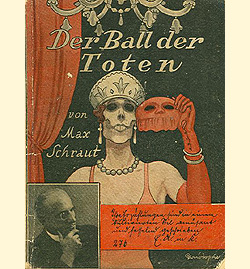 1919-1934. The great German detective,
Harald Harst, begins solving crimes in Berlin. Initially he
is only a prosecutor, but his fiancée, Marga Milden, is murdered,
and Harst quits his job to pursue the murderers. He takes Max Schraut
as an assistant. Schraut, a pickpocket known as “Comedian Max,” has
just escaped from prison to attend the burial of his mother. The kindly
Harst agrees not to turn Schraut in until the funeral is over. In return,
Schraut helps him to track down the killers of Marga Milden. After the killers
are safely apprehended, Harst and Schraut remain together for many other
adventures.
1919-1934. The great German detective,
Harald Harst, begins solving crimes in Berlin. Initially he
is only a prosecutor, but his fiancée, Marga Milden, is murdered,
and Harst quits his job to pursue the murderers. He takes Max Schraut
as an assistant. Schraut, a pickpocket known as “Comedian Max,” has
just escaped from prison to attend the burial of his mother. The kindly
Harst agrees not to turn Schraut in until the funeral is over. In return,
Schraut helps him to track down the killers of Marga Milden. After the killers
are safely apprehended, Harst and Schraut remain together for many other
adventures.
Harst is tall and gentlemanly as well as independently wealthy.
He is intelligent, a crack shot, and smokes opium-laced cigarettes. Schraut
is short and corpulent and a little bit stupid, but provides the muscle
for Harst as well contacts in the German underworld.
Harst dies in 1934, drowned in the Baltic Sea off the coast of Swinemuende,
fighting a criminal mastermind. (“Max Schraut”/Walther Kabel’s Harald
Harst - Aus meinem Leben #1-372, 1919-1934). (see also 1929).
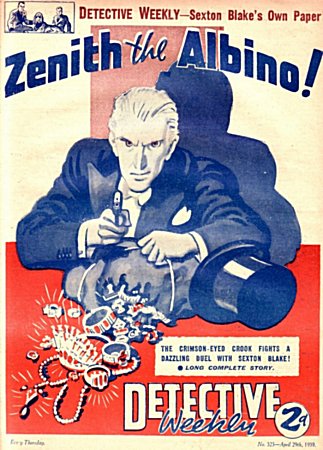 1919-1940. The Romanian/Hohenzollern
prince Zenith the Albino begins his career as a gentleman thief
and as the enemy of Sexton Blake. He is a violinist of rare ability,
an Olympic-level fencer, and an superb athlete. He also smokes opium
at a prodigious clip, is willing to use his sword-cane lethally, uses
his own inventions (including infrared binoculars and special diamond-tipped
drills) for criminal ends, is widely known, respected, and feared within
the English and French underworlds, and views civilization and its laws
with scorn. He has a code of honor, and always treats Blake fairly, but
he is an adrenaline-junky and only gets thrills and pleasure from dangerous
acts and from the duel with Blake.
1919-1940. The Romanian/Hohenzollern
prince Zenith the Albino begins his career as a gentleman thief
and as the enemy of Sexton Blake. He is a violinist of rare ability,
an Olympic-level fencer, and an superb athlete. He also smokes opium
at a prodigious clip, is willing to use his sword-cane lethally, uses
his own inventions (including infrared binoculars and special diamond-tipped
drills) for criminal ends, is widely known, respected, and feared within
the English and French underworlds, and views civilization and its laws
with scorn. He has a code of honor, and always treats Blake fairly, but
he is an adrenaline-junky and only gets thrills and pleasure from dangerous
acts and from the duel with Blake.
Though a criminal many times over, on occasion Zenith helps the police
to catch those criminals who he views as lacking honor. But that happens
only rarely; ordinarily Zenith is a thief, responsible for an interesting
variety of crimes, usually finance-related. On one occasion Zenith panicks
the English stock market by having a group of newspapers print a false
declaration of war, thus aiding Zenith's bank accounts by no small measure.
Occasionally Zenith assists other criminals who are Blake's enemies,
including the Black Trinity, the children of the king of the Central
European country of Millenia, the Chinese Mandarian Wu Ling (a probable
ally to Fu Manchu), and Leon Kestrel (the Master Mummer).
Zenith's fortunes waxed and waned in the decades in which he
fought Blake. On occasion the albino was reduced to utter penury, unable
even to afford the opium which provided his only release (apart from action)
from the ennui of life. On other occasions Zenith was wealthy enough
to able to outfit his servants (the Japanese Oyani family) in a high style
and to afford numerous well-appointed apartments across England.
Zenith's last recorded sighting was during a fight with Sexton
Blake in the middle of the German bombing of London in 1940. An explosion
separated the two, and when Blake went to look for Zenith he could not
find the albino's body. ("Anthony Skene"/George Norman Philip’s Sexton
Blake stories, beginning with “A Duel to the Death,” 1919). (see also
1914 above).
 1919. Rolf Brand, a “Great Detective Syndrome”
sufferer, begins work in Berlin. He is active across Europe.
(Rolf Brand, der Deutsche Sherlok Holmes #1-36, 1919). The
Berlin portrayed in the Rolf Brand stories is clearly fictionalized
by Brand's biographer, as the Berlin of 1919 was in considerably worse
a state than Brand’s biographer could bear to describe.
1919. Rolf Brand, a “Great Detective Syndrome”
sufferer, begins work in Berlin. He is active across Europe.
(Rolf Brand, der Deutsche Sherlok Holmes #1-36, 1919). The
Berlin portrayed in the Rolf Brand stories is clearly fictionalized
by Brand's biographer, as the Berlin of 1919 was in considerably worse
a state than Brand’s biographer could bear to describe.
Demonios, now released from the military hospital where
he was recuperating, begins his decades-long reign of terror in France,
the viciousness of his crimes recalling Fantômas' excesses.
Demonios is opposed by Luc Mahor, a policeman who had been his friend
before the wound. Many years later Mahor defeats Demonios and helps rehabilitate
him, and Démonios becomes the head of a philanthropic organization
rehabilitating down-on-their-luck criminals.
After World War One ends Hans Farrow takes his U-boat and
crew and flees from the victorious Allied forces in the Atlantic. They
wander around the seas of the world until they discover the South Seas
atoll which Captain Nemo formerly used to resupply the Nautilus.
Farrow establishes a base there and spends the rest of his life aiding
Germany's military against its enemies. (Rolf Torring #92). (see
also 1931 below). It is known that a "Miss Diver" took command
of the Nautilus following the death of Nemo in 1910; her final
fate is unknown.
Jules De Grandin begins work for the French Intelligence
agencies. (Seabury Quinn’s Jules De Grandin stories, beginning in
1925).
An unassuming Italian student, Audreses, puts on a mask and becomes the
crime-fighting Phantom Athlete to help his girlfriend Jenny. (Renee
De Liot's L'Atleta Fantasma, 1919).
Jimmy Pinkerton, the son of Nat Pinkerton,
begins work as a private detective. (Jimmy Pinkerton, 1919).
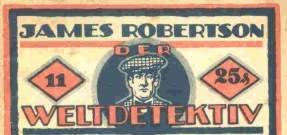 The German consulting detective James Robertson
begins a series of adventures which take him around the world. (Kurt
Falkenstein’s James Robertson, Der Weltdetektiv #1-136, 1919-1922,
and #1-17, 1923).
The German consulting detective James Robertson
begins a series of adventures which take him around the world. (Kurt
Falkenstein’s James Robertson, Der Weltdetektiv #1-136, 1919-1922,
and #1-17, 1923).
The great German aviator Hans Stark begins his
adventures. In the countryside of post-war Germany the teenaged Stark
(who was too young to have taken part in the War) discovers a set of
advanced technology formerly owned by Captain Mors and uses it
to create an advanced aircraft. The ship is ten meters long, powered
by twenty-five batteries, and capable of a speed of 400 km/hour. It has
retractable wings and can change itself into a submarine. It is armed
with machine guns and a bow heat ray. With this craft Stark travels around
the world, fighting Bedouin, rioting Indians, Mexican insurgents, and bloodthirsty
Zulus, in locales from Australia to North Africa to the USSR. In 1950 his
son takes a ship into space and has a fantastic set of adventures there.
(Hans Stark, Der Fliegerteufel #1-38, 1919-1920, and Hans Stark,
der Weltraumfahrer #1, 1950).
The English adventurer Lord Stuart begins a series
of adventures which take him around the world and bring him into
contact with a colorful variety of opponents. He is heavily influenced
by Arsène Lupin. (Ernst Pinkert’s Lord Stuart, der
Große Abenteurer #1-76, 1919-1925). It is not recorded whether
Lord Stuart ever encountered Lupin. As far as is known, Lord Stuart
was not related to Percy Stuart).
 1920. The world-famous German adventurer
Frank Allan begins his career as an adventurer and do-gooder.
He goes wherever he is needed, fighting opium smugglers in China, submarine
pirates in the Pacific, evil Indians in the American West, rioting
prisoners in Sing-Sing, the masked "Scorpion" in New York City, the
evil Chain Bearer of Krakow, jewel thieves on the Orient Express,
pirates on the Yangtze, art thieves in Tokyo (who took the "urn of
the Mikado"), the Wolf of Bucharest, the Vampire of Baltimore, Mr.
Satan, and much, much more. (Frank Allan, der Rächer der Enterbten
#1-612, 1920-1932, and #1-55, 1930-1932). (see also 1929 and 1932,
below).
1920. The world-famous German adventurer
Frank Allan begins his career as an adventurer and do-gooder.
He goes wherever he is needed, fighting opium smugglers in China, submarine
pirates in the Pacific, evil Indians in the American West, rioting
prisoners in Sing-Sing, the masked "Scorpion" in New York City, the
evil Chain Bearer of Krakow, jewel thieves on the Orient Express,
pirates on the Yangtze, art thieves in Tokyo (who took the "urn of
the Mikado"), the Wolf of Bucharest, the Vampire of Baltimore, Mr.
Satan, and much, much more. (Frank Allan, der Rächer der Enterbten
#1-612, 1920-1932, and #1-55, 1930-1932). (see also 1929 and 1932,
below).
Furio Almirante moves to a small farm in Missouri.
Almirante is an Italian who desires a peaceful, quiet life. Unfortunately,
soon after his emigration to the United States he receives a letter
from Milan, a letter which begins his world-spanning adventures. Almirante
confronts a wide range of evil men. Luckily, he is an enormous man,
“the mysterious pugilist,” the “man with the steel fist,” and is quite
capable of thrashing anyone who attempts to do evil in his presence.
During WW2 he enlists in the Italian army, and for a brief time after
the war he becomes a masked vigilante. Through it all he is assisted by
his loving gorilla friend Serafino. (Gianluigi Bonelli’s Furio Almirante
stories, beginning in 1940).
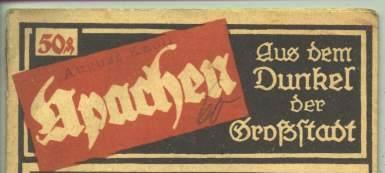 A street gang known as the Apaches organizes in
New York City and fights a colorful variety of opponents, including
"the Vampire of New York," the "King of the Air," the "devil of Wall
Street," and the "sailboat of death." (Apachen - Aus dem Dunkel
der Großstadt #1-69, 1920-1921).
A street gang known as the Apaches organizes in
New York City and fights a colorful variety of opponents, including
"the Vampire of New York," the "King of the Air," the "devil of Wall
Street," and the "sailboat of death." (Apachen - Aus dem Dunkel
der Großstadt #1-69, 1920-1921).
 Billy Jenkins begins adventuring. He was born Erich Rudolf Otto Rosenthal,
in 1895 in Germany, and ran away to sea as a young boy. He briefly fought
in the Boer War and then made his way as a teenager to the American West,
where he worked as a cowboy. Up to this point, all the history books agree.
But the orthodox history books go on to describe only his experience as
a horseman in the circuses of America and Europe, including the Circus Sarrasani,
and his experiences running a circus in Germany in the 1930s. What these
history books do not describe is his work as an agent for American government.
Beginning in 1920 Jenkins fought crime and evil across the American West,
in Alaska, and in Central and South America for almost twenty years, splitting
time between his circus and his duties as a law enforcement agent. He was
assisted by a Cheyenne, "Hunting Wolf," and by his pet wolf Husky. Together,
they crossed decayed graveyards, ghost towns, abandoned mines, and lonely
mountains, fighting zombies, killer plagues, gold thieves and car hijackers.
On occasion Jenkins helped and was helped by Hans Stosch-Sarrasani.
Jenkins' circus was destroyed by arson set by the Nazis in 1940, and Jenkins
was supposed to have died, poor and crippled (from injuries sustained during
the fire which destroyed his circus), in 1954. (Billy Jenkins #1-4,
1930, Billy Jenkins, Der Zirkuskönig #1-264, 1934-1939, and an
unknown number of issues from 1949-1963). Jenkins may have been one of the
“Celluloid Adventurers;” see Note #7.
Billy Jenkins begins adventuring. He was born Erich Rudolf Otto Rosenthal,
in 1895 in Germany, and ran away to sea as a young boy. He briefly fought
in the Boer War and then made his way as a teenager to the American West,
where he worked as a cowboy. Up to this point, all the history books agree.
But the orthodox history books go on to describe only his experience as
a horseman in the circuses of America and Europe, including the Circus Sarrasani,
and his experiences running a circus in Germany in the 1930s. What these
history books do not describe is his work as an agent for American government.
Beginning in 1920 Jenkins fought crime and evil across the American West,
in Alaska, and in Central and South America for almost twenty years, splitting
time between his circus and his duties as a law enforcement agent. He was
assisted by a Cheyenne, "Hunting Wolf," and by his pet wolf Husky. Together,
they crossed decayed graveyards, ghost towns, abandoned mines, and lonely
mountains, fighting zombies, killer plagues, gold thieves and car hijackers.
On occasion Jenkins helped and was helped by Hans Stosch-Sarrasani.
Jenkins' circus was destroyed by arson set by the Nazis in 1940, and Jenkins
was supposed to have died, poor and crippled (from injuries sustained during
the fire which destroyed his circus), in 1954. (Billy Jenkins #1-4,
1930, Billy Jenkins, Der Zirkuskönig #1-264, 1934-1939, and an
unknown number of issues from 1949-1963). Jenkins may have been one of the
“Celluloid Adventurers;” see Note #7.
The German-American detective Will Morton begins
a series of adventures which take him around the world. He is based
in New York City, but the majority of his cases take place outside
the United States. (Kleine Detektiv-Romane #1-370, 1920-1927).
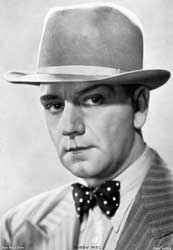
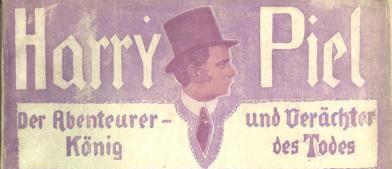 The movie star Harry Piel begins adventuring. Harry
Piel was born Hubert August Piel in Düsseldorf in 1892. His career in
film began in 1913, and for forty years he wrote, acted, and directed. He
worked in a variety of genres and was successful in every one of them, whether
playing a clown in a circus film, acting the romantic lead opposite Marlene
Dietrich, or performing as an action/adventure hero. He acted in 110 films
and was, in his time, a legitimate star, albeit one far better known in Europe
than in Americ. His downfall came in the 1930s, when the German people gave
the Nazi Party power in popular elections. Piel entered the Nazi Party and
became a public relations officer for the SS. For this he was imprisoned for
six months after the war, and after emerging from prison he found that his
career as a star was over. He died, poor, in 1963.
The movie star Harry Piel begins adventuring. Harry
Piel was born Hubert August Piel in Düsseldorf in 1892. His career in
film began in 1913, and for forty years he wrote, acted, and directed. He
worked in a variety of genres and was successful in every one of them, whether
playing a clown in a circus film, acting the romantic lead opposite Marlene
Dietrich, or performing as an action/adventure hero. He acted in 110 films
and was, in his time, a legitimate star, albeit one far better known in Europe
than in Americ. His downfall came in the 1930s, when the German people gave
the Nazi Party power in popular elections. Piel entered the Nazi Party and
became a public relations officer for the SS. For this he was imprisoned for
six months after the war, and after emerging from prison he found that his
career as a star was over. He died, poor, in 1963.
To repeat a common refrain here, the preceding is the only part of his
biography which has made it into orthodox, standard history books. Piel's
biographers of the 1920s and 1930s told a much different and more interesting
story, little-known though it is today, even to ardent cineastes.
Beginning in 1920 and lasting for almost a decade, in between shooting his
films Piel led a life of adventure vigorous enough to gain him the nickname
"the gentleman of the world." He traveled around the world, imitating Frank
Allan and John Kling and defending innocent men and women against
oppression and evil. It could hardly have been coincidental that one of his
first films was Die Luftpiraten (1920); "die luftpirat" was
the nickname for the notorious Captain Mors. (Harry Piel, Der
Tollkühne Detektiv #1-92, 1920-1923, Harry Piel, Der Abenteurer-König
#1-150, 1922-1926, and Harry Piel, Abenteuer #1, 1928). Piel
may have been one of the “Celluloid Adventurers” (see Note #7).
Fred Pinkerton, the son of Nat Pinkerton
and the brother of Jimmy Pinkerton, begins solving crimes
as an adventurer and detective. Although most of his cases take place
in America, on a number of occasions he crisscrosses the world in the
course of a case. He is assisted by Lord, his bloodhound. (Fred Pinkerton,
Amerikas Meisterdetektiv #1-140, 1920-1921).
Captain Seehorst, a German sailor and adventurer,
travels around the world, finding adventure wherever he goes. On
various occasions he helps an Indian Rajah recapture a stolen diamond,
fights pirates in the Indian Ocean, escapes from a pit of scorpions in
Africa, fights a “death cult” in Japan, female thieves in Samoa, and
Zulus in South Africa. (Leopold Wogenhart’s Detektiv-Abenteuer des
Kapitän Seehorst #1-21, 1920).
Timeline: To
1800.
Timeline: 1801-1859.
Timeline: 1860-1900.
Timeline: 1901-1910.
Timeline: 1921-1930.
Timeline: 1931-1945.
Notes.
Some Unknown Members
of the Wold Newton Family Tree.
 Jonas Fjeld begins a decades-long series of adventures.
Dr. Jonas Fjeld is an enormous, muscular blond Norwegian who lives
in a sprawling castle on the Uranienborg. He is a brilliant scientist
and inventor who is dedicated to warring on the "intenational underworld."
He is assisted in this by his friend and collaborator Ilmari Erko,
a Finnish dwarf and genius inventor who provides Fjeld with his advanced
instruments and weapons and vehicles, such as the Flyvefisken,
a plane/submarine with high-tech weaponry which is capable of sinking
most of the Russian fleet by itself. (Øvre Richter Frich's Jonas
Fjeld novels, beginning with De knyttede naever, 1911).
Jonas Fjeld begins a decades-long series of adventures.
Dr. Jonas Fjeld is an enormous, muscular blond Norwegian who lives
in a sprawling castle on the Uranienborg. He is a brilliant scientist
and inventor who is dedicated to warring on the "intenational underworld."
He is assisted in this by his friend and collaborator Ilmari Erko,
a Finnish dwarf and genius inventor who provides Fjeld with his advanced
instruments and weapons and vehicles, such as the Flyvefisken,
a plane/submarine with high-tech weaponry which is capable of sinking
most of the Russian fleet by itself. (Øvre Richter Frich's Jonas
Fjeld novels, beginning with De knyttede naever, 1911).  The German adventurer and detective Jack Franklin
has a series of adventures throughout the year. For a brief time
he is known as the "World Detective," largely due to the global scale
of his adventures, which bring him from Bombay to East St. Louis to
Warsaw. (Jack Franklin, der Meisterdetektiv #1-41, 1911). Later
researchers have noted Franklin's strong resemblance to Nick Carter,
but no relationship between them has been established. Similarly, a number
of Franklin's adventurers are startlingly similar to Carter's, but researchers
have been unable to show that this was anything other than coincidence.
The German adventurer and detective Jack Franklin
has a series of adventures throughout the year. For a brief time
he is known as the "World Detective," largely due to the global scale
of his adventures, which bring him from Bombay to East St. Louis to
Warsaw. (Jack Franklin, der Meisterdetektiv #1-41, 1911). Later
researchers have noted Franklin's strong resemblance to Nick Carter,
but no relationship between them has been established. Similarly, a number
of Franklin's adventurers are startlingly similar to Carter's, but researchers
have been unable to show that this was anything other than coincidence.  John Strobbins begins a decades-long career of theft.
Strobbins, "young, elegant, and likable," is a very patriotic American,
working out of San Francisco. He is a "virtuoso of burglary" and a master
of disguise. While he does not kill, he can be ruthless; when dealing
with spies he will, for example, inject them with leprosy and then abandon
them on a deserted island. Most of the time, however, Strobbins is a playful
and chivalrous sort, willing to tip off the police as to where he will
strike next, and on occasion helping the police to capture truly evil men.
Strobbins' police nemeses are James Molescott, the Chief of the S.F.P.D.,
and Peter Crainsby, Molescott's assistant. Strobbins is helped by his
butler/assistant Reno. (Jose Moselli's John Strobbins stories, beginning
in 1911). Many of Strobbins' methods and actions were influenced by Arsène
Lupin; it is not known what Lupin thought of Strobbins.
John Strobbins begins a decades-long career of theft.
Strobbins, "young, elegant, and likable," is a very patriotic American,
working out of San Francisco. He is a "virtuoso of burglary" and a master
of disguise. While he does not kill, he can be ruthless; when dealing
with spies he will, for example, inject them with leprosy and then abandon
them on a deserted island. Most of the time, however, Strobbins is a playful
and chivalrous sort, willing to tip off the police as to where he will
strike next, and on occasion helping the police to capture truly evil men.
Strobbins' police nemeses are James Molescott, the Chief of the S.F.P.D.,
and Peter Crainsby, Molescott's assistant. Strobbins is helped by his
butler/assistant Reno. (Jose Moselli's John Strobbins stories, beginning
in 1911). Many of Strobbins' methods and actions were influenced by Arsène
Lupin; it is not known what Lupin thought of Strobbins.  A heroic young Parisian, Tintin, begins a fabulous
series of adventures around the world, both in the skies and underground,
and then later across the solar system. In the atomic-hydrogen-gas-powered
spaceship Bolide Tintin and his friends Professor Saint-Marc,
Yvonne Blanchard, Timmy-Ropp, and Jean du Requirel travel to Mars,
where they encounter the Slavoks, a robotic race of slaves that the
Martians constructed to serve them. The Martians themselves have slender
bodies with enormous heads, and get around with the help of metal boots
and artificial wings. (Marcel Priollet's Les Voyages Aeriens d'un
Petit Parisien a Travers le Monde #1-111, 1911-1913)
A heroic young Parisian, Tintin, begins a fabulous
series of adventures around the world, both in the skies and underground,
and then later across the solar system. In the atomic-hydrogen-gas-powered
spaceship Bolide Tintin and his friends Professor Saint-Marc,
Yvonne Blanchard, Timmy-Ropp, and Jean du Requirel travel to Mars,
where they encounter the Slavoks, a robotic race of slaves that the
Martians constructed to serve them. The Martians themselves have slender
bodies with enormous heads, and get around with the help of metal boots
and artificial wings. (Marcel Priollet's Les Voyages Aeriens d'un
Petit Parisien a Travers le Monde #1-111, 1911-1913)  1912. The Turkish detective Avni begins
work in Istanbul. His methods are heavily influenced by both Sherlock
Holmes and Monsieur Lecoq, but in personality he is not
like either of them. To the criminals of Istanbul he quickly becomes
known as "Amanvermez Avni," or "Merciless Avni." (Ebüssüreyya
Sami's Avni novels, beginning in 1912).
1912. The Turkish detective Avni begins
work in Istanbul. His methods are heavily influenced by both Sherlock
Holmes and Monsieur Lecoq, but in personality he is not
like either of them. To the criminals of Istanbul he quickly becomes
known as "Amanvermez Avni," or "Merciless Avni." (Ebüssüreyya
Sami's Avni novels, beginning in 1912).  The French boxer Marcel Dunot begins a remarkable
series of adventures which lasts for almost thirty years. Dunot
is the "King of Boxers," an adventurous pugilist whose travels bring
him into contact with all sorts of criminal types. When Dunot goes
to America he tangles with the boxer Fred MacFarlan, the boss of the
criminal organisation the Black Hand. In Honduras Dunot is named the
Minister of the Navy in order to stop the civil war raging there. Dunot
fights the Black Hand in China and Russia. Dunot fights with Frank Flint,
an auto magnate, and Mathias Landers, the rubber king. In Haiti Dunot defeats
the plans of Charlemagne Sale-Trou, who planned to take over the island
and become its Emperor. During WW1 Dunot fought the Germans with extreme
savagery, traveling to Belgium, the Balkans, German East Africa and Central
America, especially the Panama Canal, and finding and killing the brutish
Germans wherever he found them. After the war it was more of the same,
Dunot tangling with Mme. Eventail, a sinister Asian bandit queen, and
later culminating with Dunot's battle against Japanese spies and the
implacable spymaster Nagoaka in Shanghai. In the late 1930s Dunot retired
to his South American mansion, living off the proceeds of the gold strike
he found in the Klondyke. (Jose Moselli’s Marcel Dunot stories, beginning
in 1912).
The French boxer Marcel Dunot begins a remarkable
series of adventures which lasts for almost thirty years. Dunot
is the "King of Boxers," an adventurous pugilist whose travels bring
him into contact with all sorts of criminal types. When Dunot goes
to America he tangles with the boxer Fred MacFarlan, the boss of the
criminal organisation the Black Hand. In Honduras Dunot is named the
Minister of the Navy in order to stop the civil war raging there. Dunot
fights the Black Hand in China and Russia. Dunot fights with Frank Flint,
an auto magnate, and Mathias Landers, the rubber king. In Haiti Dunot defeats
the plans of Charlemagne Sale-Trou, who planned to take over the island
and become its Emperor. During WW1 Dunot fought the Germans with extreme
savagery, traveling to Belgium, the Balkans, German East Africa and Central
America, especially the Panama Canal, and finding and killing the brutish
Germans wherever he found them. After the war it was more of the same,
Dunot tangling with Mme. Eventail, a sinister Asian bandit queen, and
later culminating with Dunot's battle against Japanese spies and the
implacable spymaster Nagoaka in Shanghai. In the late 1930s Dunot retired
to his South American mansion, living off the proceeds of the gold strike
he found in the Klondyke. (Jose Moselli’s Marcel Dunot stories, beginning
in 1912).  Ethel King, a Philadelphian, begins a successful
career as a female private detective. Her French biographer, Jean
Petithuguenin, is first told about her by Nick Carter himself.
(Ethel King, ein weiblicher Sherlock Holmes #1-201,
1912-1915, and Jean Petithuguenin's Ethel King, le Nick Carter
feminin #1-101, 1912-1914). Later in the year she apprehends "Jack
the Ripper." (Jean Petithuguenin's "Jack l'Éventreur, le tueur
de femmes," Ethel King #3, 1912). The "Jack the Ripper" King caught
is by all accounts different from the one caught by Allan Dickson
and Sherlock Holmes earlier in the year (see above) and different
from the one caught by Frank Allan and Sexton Blake in the
1920s, and is clearly
the "Redjac" entity rather than the original "Jack the Ripper" who
was apprehended by Holmes in 1888. (Ellery Queen's A Study in Terror).
Ethel King, a Philadelphian, begins a successful
career as a female private detective. Her French biographer, Jean
Petithuguenin, is first told about her by Nick Carter himself.
(Ethel King, ein weiblicher Sherlock Holmes #1-201,
1912-1915, and Jean Petithuguenin's Ethel King, le Nick Carter
feminin #1-101, 1912-1914). Later in the year she apprehends "Jack
the Ripper." (Jean Petithuguenin's "Jack l'Éventreur, le tueur
de femmes," Ethel King #3, 1912). The "Jack the Ripper" King caught
is by all accounts different from the one caught by Allan Dickson
and Sherlock Holmes earlier in the year (see above) and different
from the one caught by Frank Allan and Sexton Blake in the
1920s, and is clearly
the "Redjac" entity rather than the original "Jack the Ripper" who
was apprehended by Holmes in 1888. (Ellery Queen's A Study in Terror). The insane surgeon and master criminal Dr. Cornélius
Kramm makes his debut. Kramm is known as the "Sculptor of Human
Flesh" and is given to altering the features of other people against
their will. Kramm and his brother Fritz rule an international crime
syndicate known as the "Red Hand." Eventually Kramm and the Red Hand
are defeated by an international alliance of heroes led by the brilliant
scientist and adventurer Prosper Bondonnat. (Gustave LeRouge's Dr. Kramm
novels, beginning with Le Mystérieux Docteur Cornélius,
1913). For more information on Kramm, see Dr. Lofficier's dossier.
The insane surgeon and master criminal Dr. Cornélius
Kramm makes his debut. Kramm is known as the "Sculptor of Human
Flesh" and is given to altering the features of other people against
their will. Kramm and his brother Fritz rule an international crime
syndicate known as the "Red Hand." Eventually Kramm and the Red Hand
are defeated by an international alliance of heroes led by the brilliant
scientist and adventurer Prosper Bondonnat. (Gustave LeRouge's Dr. Kramm
novels, beginning with Le Mystérieux Docteur Cornélius,
1913). For more information on Kramm, see Dr. Lofficier's dossier.
 The French inventor and scientist Professor Maboul
creates the “aerobus,” a dirigible capable of traveling long distances
very quickly. He assembles a team of six professors from England,
the U.S., Germany, Spain, China and Japan, and they set forth to explore
the North Pole. Unfortunately, they encounter the “géant des
neiges” (giant of the snows), an enormous giant who tries to eat
the explorers. Maboul and the other professors escape and return in triumph
to Paris. (Georges Méliès’ La Conquête du pôle,
1912). It is obviously a part of the historical record that giants previously
existed on Earth. (Moore and O’Neill’s The League of Extraordinary
Gentlemen, v2, 2003). But nearly all of them are thought to have
been killed off centuries ago.
The French inventor and scientist Professor Maboul
creates the “aerobus,” a dirigible capable of traveling long distances
very quickly. He assembles a team of six professors from England,
the U.S., Germany, Spain, China and Japan, and they set forth to explore
the North Pole. Unfortunately, they encounter the “géant des
neiges” (giant of the snows), an enormous giant who tries to eat
the explorers. Maboul and the other professors escape and return in triumph
to Paris. (Georges Méliès’ La Conquête du pôle,
1912). It is obviously a part of the historical record that giants previously
existed on Earth. (Moore and O’Neill’s The League of Extraordinary
Gentlemen, v2, 2003). But nearly all of them are thought to have
been killed off centuries ago.  "Masque Rouge," or "Red Mask," a French master
criminal, begins his duel with the detective Mr. Barthélémy,
a.ka. "Oeil-de-Chat" (eye of the cat). Barthélémy
discovers that Red Mask is apparently the son that Barthélémy
abandoned years ago to a Romany (Gypsy) woman. Red Mask kills Henriette,
Barthélémy's daughter and Red Mask's sister, and then
drives Marguerite, Barthélémy's other daughter, insane.
But at the last Barthélémy discovers that both of his
daughter are alive and well, and that Red Mask is not, after all, Barthélémy's
son. Red Mask dies after Barthélémy throws him from a
plane. (Gaston René's Le Secret du Masque Rouge #1-38,
1912).
"Masque Rouge," or "Red Mask," a French master
criminal, begins his duel with the detective Mr. Barthélémy,
a.ka. "Oeil-de-Chat" (eye of the cat). Barthélémy
discovers that Red Mask is apparently the son that Barthélémy
abandoned years ago to a Romany (Gypsy) woman. Red Mask kills Henriette,
Barthélémy's daughter and Red Mask's sister, and then
drives Marguerite, Barthélémy's other daughter, insane.
But at the last Barthélémy discovers that both of his
daughter are alive and well, and that Red Mask is not, after all, Barthélémy's
son. Red Mask dies after Barthélémy throws him from a
plane. (Gaston René's Le Secret du Masque Rouge #1-38,
1912).  Prince Abduel Omar of Persia, the astrologist popularly
known as “Semi-Dual,” comes to the public’s notice, and begins
a career which lasts for decades. Semi-Dual becomes one of the greatest
occult detectives of the years before WW2, using his telepathy, insight
into humans, and infallible astrological predications to protect a
number of innocent men and women (usually women) from a variety of
evil men. Semi-Dual works from his office on the 20th floor of the Urania
Building in New York City. Semi-Dual’s enemies range from the very
humble–gangsters and treacherous French Foreign Legion officers–to
the mightily wicked–the Black Brotherhood, a cult of devil-worshipers
devoted to the cause of “Erlik, Commander of the Hosts of All Evil.”
(Giesy & Smith’s Semi-Dual stories, beginning in 1912).
Prince Abduel Omar of Persia, the astrologist popularly
known as “Semi-Dual,” comes to the public’s notice, and begins
a career which lasts for decades. Semi-Dual becomes one of the greatest
occult detectives of the years before WW2, using his telepathy, insight
into humans, and infallible astrological predications to protect a
number of innocent men and women (usually women) from a variety of
evil men. Semi-Dual works from his office on the 20th floor of the Urania
Building in New York City. Semi-Dual’s enemies range from the very
humble–gangsters and treacherous French Foreign Legion officers–to
the mightily wicked–the Black Brotherhood, a cult of devil-worshipers
devoted to the cause of “Erlik, Commander of the Hosts of All Evil.”
(Giesy & Smith’s Semi-Dual stories, beginning in 1912).  The Italian gentleman thief Baron Cesare Stromboli
begins an audacious, profitable, and highly successful career in crime.
He has a number of similarities, in manner, method, and personality,
to Arsène Lupin, but is enough of an individual to rise
above the “Great Detective
Syndrome" which affected so many of the detectives influenced
by Sherlock Holmes. Stromboli is an "international gentleman,"
active around the world. He is tall, thin, and elegant, a raconteur
and scholar, who is as graceful in defeat as he is in victory. He is not
nobility by birth, but was given the title of Baron after having blackmailed
the Emperor. (Jose Moselli’s Baron Stromboli stories, beginning in 1912).
Stromboli’s biographer names the emperor as “Othon II,” but this is clearly
a fictional name. It is more likely that the emperor in question was the
Austrian emperor Francis Joseph I.
The Italian gentleman thief Baron Cesare Stromboli
begins an audacious, profitable, and highly successful career in crime.
He has a number of similarities, in manner, method, and personality,
to Arsène Lupin, but is enough of an individual to rise
above the “Great Detective
Syndrome" which affected so many of the detectives influenced
by Sherlock Holmes. Stromboli is an "international gentleman,"
active around the world. He is tall, thin, and elegant, a raconteur
and scholar, who is as graceful in defeat as he is in victory. He is not
nobility by birth, but was given the title of Baron after having blackmailed
the Emperor. (Jose Moselli’s Baron Stromboli stories, beginning in 1912).
Stromboli’s biographer names the emperor as “Othon II,” but this is clearly
a fictional name. It is more likely that the emperor in question was the
Austrian emperor Francis Joseph I.  1913. Two Germans, Heinz Brandt
and his brother Fritz, enlist in the French Foreign Legion, beginning
a remarkable career. Throughout this year and the first half of the
next, the brothers serve in the Foreign Legion, helping innocent people
and supporting France against the efforts of various native peoples
in Asia and Africa. The Brandts serve proudly, despite the sadism of
the French commanders. When World War One breaks out, the Brandts desert
from the Legion and travel to Belgium tojoin the German troops. The brothers
are eventually promoted to Corporal and win the Iron Cross. They fight
the British and French across most of Europe, in every famous battle
in France, in Russia and in the Balkans. After the war ended the pair
rejoin the Foreign Legion and return to North Africa. In 1931 Heinz’s son,
Rolf Brandt, entered the Legion. (Gustav Frohlich’s Heinz Brandt
der Fremdenlegionär #1-332, 1913-1921, and Fremdenlegionär
Brandt, beginning in 1956).
1913. Two Germans, Heinz Brandt
and his brother Fritz, enlist in the French Foreign Legion, beginning
a remarkable career. Throughout this year and the first half of the
next, the brothers serve in the Foreign Legion, helping innocent people
and supporting France against the efforts of various native peoples
in Asia and Africa. The Brandts serve proudly, despite the sadism of
the French commanders. When World War One breaks out, the Brandts desert
from the Legion and travel to Belgium tojoin the German troops. The brothers
are eventually promoted to Corporal and win the Iron Cross. They fight
the British and French across most of Europe, in every famous battle
in France, in Russia and in the Balkans. After the war ended the pair
rejoin the Foreign Legion and return to North Africa. In 1931 Heinz’s son,
Rolf Brandt, entered the Legion. (Gustav Frohlich’s Heinz Brandt
der Fremdenlegionär #1-332, 1913-1921, and Fremdenlegionär
Brandt, beginning in 1956).  Chéri-Bibi, a mysterious magician and escape artist, is
charged with murdering his father. Chéri-Bibi is innocent and is
being framed by a romantic rival, Max, who combines with Chéri-Bibi's
two-timing girlfriend Vera to set Chéri-Bibi up. Chéri-Bibi
is forced to become an outlaw, and for a while becomes the king of thieves,
the thief that other thieves and the police fear, the one with the magic
touch for escape and the ability to rally other thieves to him. However,
he eventually proves himself innocent and then begins fighting crime, using
his various skills to catch the bad guys. (Gaston Leroux's Chéri-Bibi,
1930). (Those interested in further information on Chéri-Bibi are advised
to consult Dr. Lofficier's
dossier on him).
Chéri-Bibi, a mysterious magician and escape artist, is
charged with murdering his father. Chéri-Bibi is innocent and is
being framed by a romantic rival, Max, who combines with Chéri-Bibi's
two-timing girlfriend Vera to set Chéri-Bibi up. Chéri-Bibi
is forced to become an outlaw, and for a while becomes the king of thieves,
the thief that other thieves and the police fear, the one with the magic
touch for escape and the ability to rally other thieves to him. However,
he eventually proves himself innocent and then begins fighting crime, using
his various skills to catch the bad guys. (Gaston Leroux's Chéri-Bibi,
1930). (Those interested in further information on Chéri-Bibi are advised
to consult Dr. Lofficier's
dossier on him).  The New Eccentric Club, allies of Percy Stuart
(see below), come to the attention of the public and press for their
global adventures. They are a group of English gentlemen who solve
murders and similar vile crimes, both in London and around the world,
from Niagara Falls to Beijing to Paris and all points between, on the
land, under the sea’s surface, and in the air. They often worked with
Percy Stuart, but on occasion went off on their own. Sometimes they
engaged in races, to see who could cross the oceans the fastest, but
more often their stories involved murders and other vilenesses. They
are extremely selective in who they accept into their ranks, and their standards
are often eccentric (as befits their name). Usually would-be members must
pass a strenuous series of tests, and even applicants with otherwise sterling
records of crimefight, like Percy Stuart, are forced to prove themselves
before being admitted to the Club. (Der Neue Excentric Club #1-534,
1920-1927).
The New Eccentric Club, allies of Percy Stuart
(see below), come to the attention of the public and press for their
global adventures. They are a group of English gentlemen who solve
murders and similar vile crimes, both in London and around the world,
from Niagara Falls to Beijing to Paris and all points between, on the
land, under the sea’s surface, and in the air. They often worked with
Percy Stuart, but on occasion went off on their own. Sometimes they
engaged in races, to see who could cross the oceans the fastest, but
more often their stories involved murders and other vilenesses. They
are extremely selective in who they accept into their ranks, and their standards
are often eccentric (as befits their name). Usually would-be members must
pass a strenuous series of tests, and even applicants with otherwise sterling
records of crimefight, like Percy Stuart, are forced to prove themselves
before being admitted to the Club. (Der Neue Excentric Club #1-534,
1920-1927).  The “Great Detective Syndrome”
sufferer John Spurlock has a very successful year. A German-American
consulting detective, Spurlock is based in New York City but is active
around the world. He is known as “the man of a thousand disguises” but
generally takes over Sherlock Holmes in both manner and method. His
stories and enemies occasionally verge on the fantastic, as in the case
his biographer labels “the Message from Mars,” when Spurlock is almost
single-handedly responsible for defeating an incursion of the same
Martians who invaded the Earth in 1898. (Detektiv John Spurlock
#1-36, 1915). There would be other, later attempts by the Martians
to invade Earth, and they would be defeated as this one was. But, ominously,
this attack proved that the Martians were capable of adapting to Earth's
bacteria, and would require more vigorous weapons to defeat them.
The “Great Detective Syndrome”
sufferer John Spurlock has a very successful year. A German-American
consulting detective, Spurlock is based in New York City but is active
around the world. He is known as “the man of a thousand disguises” but
generally takes over Sherlock Holmes in both manner and method. His
stories and enemies occasionally verge on the fantastic, as in the case
his biographer labels “the Message from Mars,” when Spurlock is almost
single-handedly responsible for defeating an incursion of the same
Martians who invaded the Earth in 1898. (Detektiv John Spurlock
#1-36, 1915). There would be other, later attempts by the Martians
to invade Earth, and they would be defeated as this one was. But, ominously,
this attack proved that the Martians were capable of adapting to Earth's
bacteria, and would require more vigorous weapons to defeat them.  Percy Stuart, a rich, young English lord, begins
a noteworthy career of adventuring. He begins as an independent crimefight,
but when he hears about the New Eccentric Club in London he
tries to join them. But he is told that he has to solve 197 mysteries--the
solving of unpunished crimes, the discovery of missing persons, and the
like--to qualify for membership. For years Stuart solves cases, but
he is only partially able to solve the 197th case, and so, shamed, he
vows to solve another 197. His cases take him around the world, even bringing
him into the plains of America, where he drives an armored landrover
(quite similar to the inventions of Frank Reade, Jr.) and fights
off the attacks of a group of marauding natives.
Percy Stuart, a rich, young English lord, begins
a noteworthy career of adventuring. He begins as an independent crimefight,
but when he hears about the New Eccentric Club in London he
tries to join them. But he is told that he has to solve 197 mysteries--the
solving of unpunished crimes, the discovery of missing persons, and the
like--to qualify for membership. For years Stuart solves cases, but
he is only partially able to solve the 197th case, and so, shamed, he
vows to solve another 197. His cases take him around the world, even bringing
him into the plains of America, where he drives an armored landrover
(quite similar to the inventions of Frank Reade, Jr.) and fights
off the attacks of a group of marauding natives.  In the last half of the year, after World War One has begun,
the patriotic Frenchman Paul Delroze foils the schemes of the
German spy the Countess Hemine de Hohenzollern. Delroze is assisted by
Arsène Lupin. (Maurice Leblanc's L'Eclat d'Obus,
1915). The royal Hohenzollern family have traditionally been German. However,
in February 1866 Prince Carol I, of the Hohenzollern-Sigmaringens of southern
Germany, was nominated by Romanian leader Ion Bratianu to become Romania's
new prince. Carol (1839-1914) was childless, leaving his elder brother
Leopold next in line to the throne. In 1880 Leopold renounced his right
of succession in favor of his son William, who in 1888 surrendered his
claim in favor of his younger brother, King Ferdinand I (1865-1927). Ferdinand
and his wife, Princess Marie of Edinburgh, had three daughters and three
sons.
In the last half of the year, after World War One has begun,
the patriotic Frenchman Paul Delroze foils the schemes of the
German spy the Countess Hemine de Hohenzollern. Delroze is assisted by
Arsène Lupin. (Maurice Leblanc's L'Eclat d'Obus,
1915). The royal Hohenzollern family have traditionally been German. However,
in February 1866 Prince Carol I, of the Hohenzollern-Sigmaringens of southern
Germany, was nominated by Romanian leader Ion Bratianu to become Romania's
new prince. Carol (1839-1914) was childless, leaving his elder brother
Leopold next in line to the throne. In 1880 Leopold renounced his right
of succession in favor of his son William, who in 1888 surrendered his
claim in favor of his younger brother, King Ferdinand I (1865-1927). Ferdinand
and his wife, Princess Marie of Edinburgh, had three daughters and three
sons.  The Dutch female detective Enny Gold begins solving
crimes across Europe as an independent investigator. (Miss Enny
Gold, De Vrouwelyke Detective).
The Dutch female detective Enny Gold begins solving
crimes across Europe as an independent investigator. (Miss Enny
Gold, De Vrouwelyke Detective). The Dutch occult detective Harrison solves a series
of supernatural crimes. (Harrison, de Detective Spiritist).
The Dutch occult detective Harrison solves a series
of supernatural crimes. (Harrison, de Detective Spiritist).
 The Mexican rebel Francisco “Pancho” Villa begins
a series of fantastic adventures. Villa’s life became extremely interesting
in 1914, with his struggle against repressive, corrupt regime of Porfirio
Diaz gaining momentary success and bringing about, two years later,
the futile American expedition against him. But few American history
books record the other exploits of Villa’s life, beginning in 1914 and
lasting into the 1920s. Villa of course fought against the exploitive Americans
and the various bandits which preyed on the peasants and natives of Mexico.
But Villa also discovered a lost Mayan temple, defeated an evil coven of
native witches, and foiled the schemes of a Japanese spy in Mexico City.
(General Villa, der Mexikanische Rebellenführer #1-12, 1914-1916,
and then #13-51, 1920-1921).
The Mexican rebel Francisco “Pancho” Villa begins
a series of fantastic adventures. Villa’s life became extremely interesting
in 1914, with his struggle against repressive, corrupt regime of Porfirio
Diaz gaining momentary success and bringing about, two years later,
the futile American expedition against him. But few American history
books record the other exploits of Villa’s life, beginning in 1914 and
lasting into the 1920s. Villa of course fought against the exploitive Americans
and the various bandits which preyed on the peasants and natives of Mexico.
But Villa also discovered a lost Mayan temple, defeated an evil coven of
native witches, and foiled the schemes of a Japanese spy in Mexico City.
(General Villa, der Mexikanische Rebellenführer #1-12, 1914-1916,
and then #13-51, 1920-1921).  1919-1934. The great German detective,
Harald Harst, begins solving crimes in Berlin. Initially he
is only a prosecutor, but his fiancée, Marga Milden, is murdered,
and Harst quits his job to pursue the murderers. He takes Max Schraut
as an assistant. Schraut, a pickpocket known as “Comedian Max,” has
just escaped from prison to attend the burial of his mother. The kindly
Harst agrees not to turn Schraut in until the funeral is over. In return,
Schraut helps him to track down the killers of Marga Milden. After the killers
are safely apprehended, Harst and Schraut remain together for many other
adventures.
1919-1934. The great German detective,
Harald Harst, begins solving crimes in Berlin. Initially he
is only a prosecutor, but his fiancée, Marga Milden, is murdered,
and Harst quits his job to pursue the murderers. He takes Max Schraut
as an assistant. Schraut, a pickpocket known as “Comedian Max,” has
just escaped from prison to attend the burial of his mother. The kindly
Harst agrees not to turn Schraut in until the funeral is over. In return,
Schraut helps him to track down the killers of Marga Milden. After the killers
are safely apprehended, Harst and Schraut remain together for many other
adventures.  1919-1940. The Romanian/Hohenzollern
prince Zenith the Albino begins his career as a gentleman thief
and as the enemy of Sexton Blake. He is a violinist of rare ability,
an Olympic-level fencer, and an superb athlete. He also smokes opium
at a prodigious clip, is willing to use his sword-cane lethally, uses
his own inventions (including infrared binoculars and special diamond-tipped
drills) for criminal ends, is widely known, respected, and feared within
the English and French underworlds, and views civilization and its laws
with scorn. He has a code of honor, and always treats Blake fairly, but
he is an adrenaline-junky and only gets thrills and pleasure from dangerous
acts and from the duel with Blake.
1919-1940. The Romanian/Hohenzollern
prince Zenith the Albino begins his career as a gentleman thief
and as the enemy of Sexton Blake. He is a violinist of rare ability,
an Olympic-level fencer, and an superb athlete. He also smokes opium
at a prodigious clip, is willing to use his sword-cane lethally, uses
his own inventions (including infrared binoculars and special diamond-tipped
drills) for criminal ends, is widely known, respected, and feared within
the English and French underworlds, and views civilization and its laws
with scorn. He has a code of honor, and always treats Blake fairly, but
he is an adrenaline-junky and only gets thrills and pleasure from dangerous
acts and from the duel with Blake.  1919. Rolf Brand, a “Great Detective Syndrome”
sufferer, begins work in Berlin. He is active across Europe.
(Rolf Brand, der Deutsche Sherlok Holmes #1-36, 1919). The
Berlin portrayed in the Rolf Brand stories is clearly fictionalized
by Brand's biographer, as the Berlin of 1919 was in considerably worse
a state than Brand’s biographer could bear to describe.
1919. Rolf Brand, a “Great Detective Syndrome”
sufferer, begins work in Berlin. He is active across Europe.
(Rolf Brand, der Deutsche Sherlok Holmes #1-36, 1919). The
Berlin portrayed in the Rolf Brand stories is clearly fictionalized
by Brand's biographer, as the Berlin of 1919 was in considerably worse
a state than Brand’s biographer could bear to describe.  The German consulting detective James Robertson
begins a series of adventures which take him around the world. (Kurt
Falkenstein’s James Robertson, Der Weltdetektiv #1-136, 1919-1922,
and #1-17, 1923).
The German consulting detective James Robertson
begins a series of adventures which take him around the world. (Kurt
Falkenstein’s James Robertson, Der Weltdetektiv #1-136, 1919-1922,
and #1-17, 1923).  1920. The world-famous German adventurer
Frank Allan begins his career as an adventurer and do-gooder.
He goes wherever he is needed, fighting opium smugglers in China, submarine
pirates in the Pacific, evil Indians in the American West, rioting
prisoners in Sing-Sing, the masked "Scorpion" in New York City, the
evil Chain Bearer of Krakow, jewel thieves on the Orient Express,
pirates on the Yangtze, art thieves in Tokyo (who took the "urn of
the Mikado"), the Wolf of Bucharest, the Vampire of Baltimore, Mr.
Satan, and much, much more. (Frank Allan, der Rächer der Enterbten
#1-612, 1920-1932, and #1-55, 1930-1932). (see also 1929 and 1932,
below).
1920. The world-famous German adventurer
Frank Allan begins his career as an adventurer and do-gooder.
He goes wherever he is needed, fighting opium smugglers in China, submarine
pirates in the Pacific, evil Indians in the American West, rioting
prisoners in Sing-Sing, the masked "Scorpion" in New York City, the
evil Chain Bearer of Krakow, jewel thieves on the Orient Express,
pirates on the Yangtze, art thieves in Tokyo (who took the "urn of
the Mikado"), the Wolf of Bucharest, the Vampire of Baltimore, Mr.
Satan, and much, much more. (Frank Allan, der Rächer der Enterbten
#1-612, 1920-1932, and #1-55, 1930-1932). (see also 1929 and 1932,
below).  A street gang known as the Apaches organizes in
New York City and fights a colorful variety of opponents, including
"the Vampire of New York," the "King of the Air," the "devil of Wall
Street," and the "sailboat of death." (Apachen - Aus dem Dunkel
der Großstadt #1-69, 1920-1921).
A street gang known as the Apaches organizes in
New York City and fights a colorful variety of opponents, including
"the Vampire of New York," the "King of the Air," the "devil of Wall
Street," and the "sailboat of death." (Apachen - Aus dem Dunkel
der Großstadt #1-69, 1920-1921).  Billy Jenkins begins adventuring. He was born Erich Rudolf Otto Rosenthal,
in 1895 in Germany, and ran away to sea as a young boy. He briefly fought
in the Boer War and then made his way as a teenager to the American West,
where he worked as a cowboy. Up to this point, all the history books agree.
But the orthodox history books go on to describe only his experience as
a horseman in the circuses of America and Europe, including the Circus Sarrasani,
and his experiences running a circus in Germany in the 1930s. What these
history books do not describe is his work as an agent for American government.
Beginning in 1920 Jenkins fought crime and evil across the American West,
in Alaska, and in Central and South America for almost twenty years, splitting
time between his circus and his duties as a law enforcement agent. He was
assisted by a Cheyenne, "Hunting Wolf," and by his pet wolf Husky. Together,
they crossed decayed graveyards, ghost towns, abandoned mines, and lonely
mountains, fighting zombies, killer plagues, gold thieves and car hijackers.
On occasion Jenkins helped and was helped by Hans Stosch-Sarrasani.
Jenkins' circus was destroyed by arson set by the Nazis in 1940, and Jenkins
was supposed to have died, poor and crippled (from injuries sustained during
the fire which destroyed his circus), in 1954. (Billy Jenkins #1-4,
1930, Billy Jenkins, Der Zirkuskönig #1-264, 1934-1939, and an
unknown number of issues from 1949-1963). Jenkins may have been one of the
“Celluloid Adventurers;” see Note #7.
Billy Jenkins begins adventuring. He was born Erich Rudolf Otto Rosenthal,
in 1895 in Germany, and ran away to sea as a young boy. He briefly fought
in the Boer War and then made his way as a teenager to the American West,
where he worked as a cowboy. Up to this point, all the history books agree.
But the orthodox history books go on to describe only his experience as
a horseman in the circuses of America and Europe, including the Circus Sarrasani,
and his experiences running a circus in Germany in the 1930s. What these
history books do not describe is his work as an agent for American government.
Beginning in 1920 Jenkins fought crime and evil across the American West,
in Alaska, and in Central and South America for almost twenty years, splitting
time between his circus and his duties as a law enforcement agent. He was
assisted by a Cheyenne, "Hunting Wolf," and by his pet wolf Husky. Together,
they crossed decayed graveyards, ghost towns, abandoned mines, and lonely
mountains, fighting zombies, killer plagues, gold thieves and car hijackers.
On occasion Jenkins helped and was helped by Hans Stosch-Sarrasani.
Jenkins' circus was destroyed by arson set by the Nazis in 1940, and Jenkins
was supposed to have died, poor and crippled (from injuries sustained during
the fire which destroyed his circus), in 1954. (Billy Jenkins #1-4,
1930, Billy Jenkins, Der Zirkuskönig #1-264, 1934-1939, and an
unknown number of issues from 1949-1963). Jenkins may have been one of the
“Celluloid Adventurers;” see Note #7. 
 The movie star Harry Piel begins adventuring. Harry
Piel was born Hubert August Piel in Düsseldorf in 1892. His career in
film began in 1913, and for forty years he wrote, acted, and directed. He
worked in a variety of genres and was successful in every one of them, whether
playing a clown in a circus film, acting the romantic lead opposite Marlene
Dietrich, or performing as an action/adventure hero. He acted in 110 films
and was, in his time, a legitimate star, albeit one far better known in Europe
than in Americ. His downfall came in the 1930s, when the German people gave
the Nazi Party power in popular elections. Piel entered the Nazi Party and
became a public relations officer for the SS. For this he was imprisoned for
six months after the war, and after emerging from prison he found that his
career as a star was over. He died, poor, in 1963.
The movie star Harry Piel begins adventuring. Harry
Piel was born Hubert August Piel in Düsseldorf in 1892. His career in
film began in 1913, and for forty years he wrote, acted, and directed. He
worked in a variety of genres and was successful in every one of them, whether
playing a clown in a circus film, acting the romantic lead opposite Marlene
Dietrich, or performing as an action/adventure hero. He acted in 110 films
and was, in his time, a legitimate star, albeit one far better known in Europe
than in Americ. His downfall came in the 1930s, when the German people gave
the Nazi Party power in popular elections. Piel entered the Nazi Party and
became a public relations officer for the SS. For this he was imprisoned for
six months after the war, and after emerging from prison he found that his
career as a star was over. He died, poor, in 1963.